 PathScribe
PathScribe
The PathScribe component of VectorScribe consists of the PathScribe tool and the PathScribe panel. While the tool can be used alone, much of PathScribe’s functionality is accessed through the panel.
This functionality includes the ability to:
Select multiple handles, and collectively move, extend, rotate, or retract them
Extend or retract handles without changing their angles
Copy and paste handles
Edit anchor point positions and handle positions, lengths or angles numerically
Equalize a point’s handles, or the handles on either side of a path segment
Work with connector points (transitions between straight and curved segments)
Use “slow-drag” to gear down cursor movement for extremely precise moves
Remove one or more anchor points while keeping the curve as close to the original as possible Add or move points to a path’s horizontal or vertical tangencies
Add variable numbers of points to path segments
Close multiple paths, retaining endpoint handles or not
Visualize and remove all redundant points on multiple paths
Set, grow, shrink, or invert the current point selection
PathScribe Tool
Overview, Cursor Snapping, and Slow-Drag
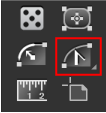
PathScribe Tool Location
The PathScribe tool is used to click on or drag direction handles, anchor points, and path segments; it can also be dragged from a blank area of the document as a marquee to select handles or points. When the tool is selected and held over a blank area of the document, the cursor looks like an inverted “V,” similar to the Convert Anchor Point tool, but thicker, so as to distinguish it.
The cursor will change its appearance to give you feedback, depending on several factors: what lies underneath, whether you are dragging or not, and what modifier keys are being held down.

PathScribe Cursors
In addition, by default, PathScribe draws a red ring around the cursor and a text label when it is snapping to an item of interest (handle, anchor point, path segment). This behaviour can be customized or disabled in the tool’s preferences.

PathScribe Point Handles snapping rings
When Smart Guides are on, PathScribe snaps as usual using the radius value set in Illustrator Preferences > Smart Guides > Snapping Tolerance. When Smart Guides are off, PathScribe snaps using the snapping radius you have set in Illustrator Preferences > Selection & Anchor Display > Selection > Tolerance, plus one pixel.
Making precise adjustments to handle positions with one of the selection tools is often frustrating because you may need to zoom in so far that you can’t see everything you need to. PathScribe offers a feature called “slow-drag” that can help you.
To use slow-drag, hold down the Control key on Mac, or the Ctrl key on Windows (note: the Use Ctrl Key to Toggle Slow-Drag preference must be enabled). The cursor will show a small “S” to remind you that you are slow-dragging. The cursor’s movement will be divided by a value called the slow-drag divider (settable in the preferences). For example, at 100% View, each pixel corresponds to the unit of length of one point. You can normally move a handle, therefore, only in one-point increments at this view. But if you set the slow-drag divider to 10 and move the cursor, each pixel of movement will move the handle by only 0.1 points:

PathScribe slow-drag
Slow-drag can be used when dragging handles (single or multiple), points, and paths, and in combination with the other modifier keys. If Smart Guides were enabled when you started dragging, you can also press the U key to temporarily turn them off.
Single Handle Operations
Clicking
Clicking on a handle without any modifier keys will simply select the handle’s associated point (the point will also become selected whenever one of its handles is modified, as below). Note that unlike with the Direct Selection tool, other paths are not affected: if they were fully- or partially-selected, they remain so. To deselect everything, click on a blank area of the document.
Adding one more modifier keys while clicking a handle changes or adds functionality. As with all Astute tool keypresses, most of these will be indicated on the Astute Buddy panel.
Shift:
Shift-clickingon a handle will, by default, add or remove the handle’s associated point from the selection. However, by enabling the preference Shift-Clicking Equalizes Handle Lengths, you change this functionality.Shift-clickingon a handle with the preference set will adjust the handle’s length to match the point’s other handle. If the other handle is completely retracted, then the clicked handle will be retracted as well.

VectorScribe PathScribe handle equalization
Option/Alt:
Option/Alt-clickingon a handle will change the type of point from corner to smooth or vice versa. (When cursor highlighting with text annotations is enabled, which it is by default, you can determine a point’s type by holding the cursor over it.) When a smooth point is converted to a corner point, neither handle is changed. When a corner point is converted to a smooth point, and it has two handles, the clicked handle will move, changing its angle so it is opposite (180° from) the existing handle.Shift+Option/Alt:
Shift+Option/Alt-clickingon a handle will retract the handle. The point type remains unchanged.
Dragging
Dragging a handle will move it in the same manner as the Direct Selection tool (unless connector point recognition is enabled and the point is a connector point; see Connector Points). While dragging, there are various keys which can be pressed to perform additional functions:
Shift: Constrains the handle angle to 45° increments around the general constrain angle.
Option/Alt: Constrains the handle’s angle to its original angle, or the angle that is 180° away from the original angle (this lets you flip which side the handle is on if you drag it back past its originating point).

VectorScribe PathScribe handle angle constraining
Shift+Option/Alt: Same as
Option/Alt-dragging, except when Smart Guides are turned on. In this case, the handle will snap to other items on the page while remaining constrained to its original angle.Control [Mac only]: Toggles slow-drag.
Command/Ctrl: On Mac, hides handle annotations; on Windows, either toggles slow-drag or hides handle annotations, depending on the preference setting (see PathScribe: Preferences).
Space bar: Temporarily locks the handle’s anchor point to the handle’s so they move in tandem.
C: Changes the handle’s anchor point to corner type.
L: Toggles length constraining. When the handle’s length is constrained, you can only change its angle.
R: Retracts the handle completely.
S: Changes the handle’s anchor point to smooth type.
Multiple Handle Operations
PathScribe can select and edit multiple handles simultaneously. To select multiple handles using the PathScribe tool, they must first be visible on the screen. You can show all the handles on a path by either having part of the path selected and clicking the “Show handles on selected paths” button on the PathScribe panel, or by using the PathScribe tool to Option/Alt-marquee over a small section of a path, being careful not to select any points. Once the handles are visible, simply marquee them with the PathScribe tool by dragging out a rectangle that encloses them. Handles which are selected change from the default solid circles to larger, hollow circles (unless you have changed the display of handles to be hollow, in which case selected handles will be solid).

VectorScribe PathScribe marquee handle selection
You can also select the points whose handles you wish to select and use the first three menu items in the Handle Selection submenu of the PathScribe panel flyout menu.
Handles made visible with Illustrator’s Show Handles When Multiple Anchors are Selected preference may not be marquee-selectable with PathScribe. To avoid the problem, either turn the preference off, or only use the PathScribe tool to select paths and points.
You can use the Shift key while marqueeing to add or subtract handles from the current selection. To deselect all selected handles, click on a blank area of the document. If no handles fall within the marqueed rectangle, PathScribe will check for and select points or path segments instead. (You can also ignore handles and only select points or segments by holding down Option/Alt during the marquee operation.)
When one or more handles are selected, PathScribe enters “Multi-Handle Mode”. The cursor changes to show an icon of two handles to remind you of this. While in this mode, you can’t edit anything else, like an unselected handle or a point. You can Option/Alt-click on unselected paths to show their handles. But if you switch to another tool, you will lose the handle selection. If you hold down Command/Ctrl to temporarily switch to one of the selection (arrow) tools, and you modify a path that contains selected handles, they will become unselected.
Clicking
You can’t use any of the click operations on multiple handles. However, you can use the PathScribe panel to perform the same functions on them (see PathScribe Panel). If you prefer to use the panel for handle editing, you can select a single handle and do so in the same manner as multiple handles.
Dragging
When you drag one of a set of selected handles, the handle under the cursor moves in the same manner as a single dragged handle would (with one exception: connector points are not recognized in Multi-Handle Mode). How the other handles move is dependent on two preference settings (see below) and which multi-handle drag mode is active. There are four multi-handle drag modes: Constraining mode, Normal rotation mode, Counter-rotation mode, and Group mode.
Dragging in Constraining mode
If Option/Alt is held down, the angles of all of the selected handles will be constrained to their original angles. Their lengths will change in the manner explained below.
Dragging in Normal and Counter-Rotation modes
You operate in one of these modes unless the Option/Alt key or space bar are held down. Which mode is active can be seen in the bottom status line on the PathScribe panel, and you can toggle between these modes by pressing the C key when the mouse is down. In both these modes, selected handles will rotate through the same angle as the dragged handle, but in Counter-rotation mode, handles of the opposite type as the dragged handle will rotate in the opposite direction. For example, if the dragged handle is an in handle and is rotated 45° clockwise, then all selected out handles will be rotated 45° counterclockwise. If both handles of a smooth point are selected and moved in Counter-rotation mode, the point automatically becomes a corner point.
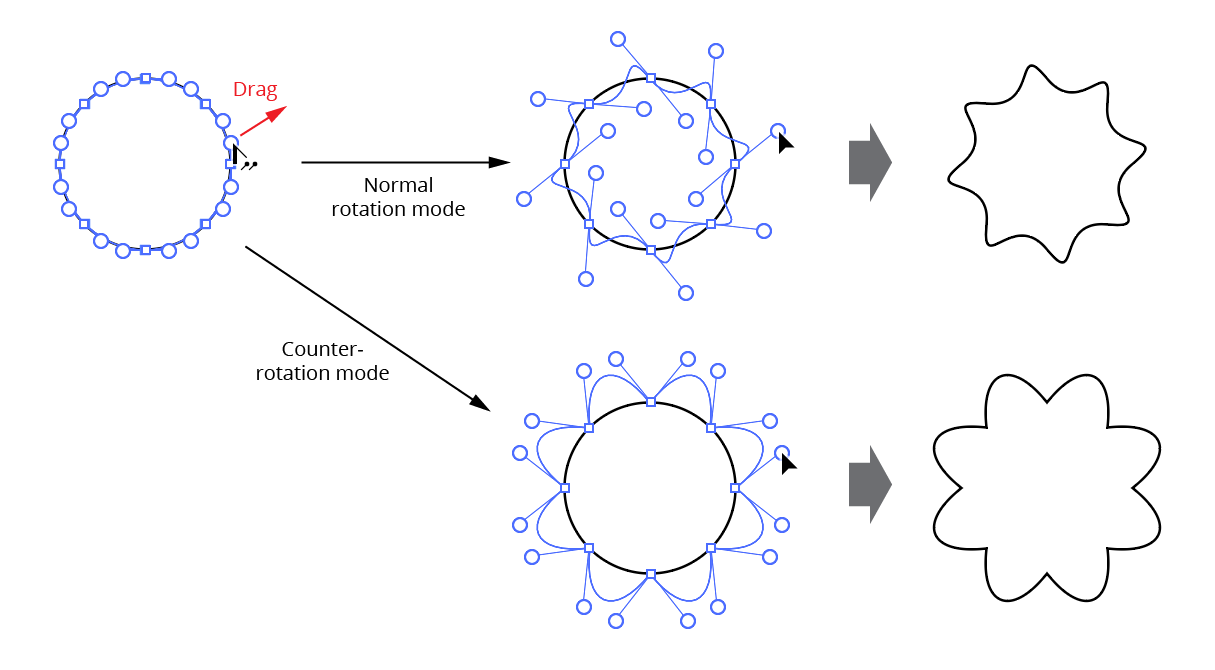
VectorScribe PathScribe multihandle normal and counter rotation
The change in each selected handle’s length depends on several preferences. By default, handles shorten or lengthen in proportion to the change in length of the dragged handle. For example, if the dragged handle was shortened to half of its original length, then all of the selected handles will be shortened to half of their original lengths. To change this behavior, see PathScribe Preferences.
Dragging in Group mode
Group mode is accessed by holding down the space bar while moving multiple handles. In this mode, all of the selected handles move as one unit in the same direction and distance as the dragged handle. As with Counter-rotation mode, if both handles of a smooth point are selected and moved, the point automatically becomes a corner point. If you begin your drag without the space bar and add it later, the angles and relative positions of all the selected handles will be restored to their original values.

VectorScribe PathScribe multihandle grouped
Point Operations
Clicking
Clicking on a point without any modifier keys selects it and deselects all other points on the path. When the Keep Paths Selected preference is enabled (the default), other paths are not affected: if they were fully- or partially selected, they remain so.
Adding one more modifier keys while clicking a point changes or adds functionality:
Shift: As with a handle, Shift-clicking on a point will, by default, add or subtract the point from the selection. However, by enabling the preference Shift-Clicking Equalizes Handle Lengths, you change this functionality. Shift-clicking on a point with the preference set will make the lengths of the point’s handles equal. The point’s type does not change. If both handles exist, the new length for each is determined by averaging the lengths of the handles. If one of the handles is retracted, a new handle is created opposite the existing handle in angle and equal to it in length.

VectorScribe PathScribe point shift click
Option/Alt: Converts the point’s type from corner to smooth or vice versa. When a smooth point is converted to a corner point, neither handle moves. When a corner point is converted to a smooth point, and both handles exist, each handle swings away from the other in equal amounts until they are 180° apart:

PathScribe Point + Option Click
Shift+Option/Alt: Retracts the point’s handles. The point type remains unchanged. If both handles are already retracted, then
Shift+Option/Alt-clickingcreates two new handles, using the algorithm described for the PathScribe panel:

PathScribe Point + Shift + Option Click
Dragging
Dragging a point moves the point along with its handles, just as the Direct Selection tool would. As with dragging a handle, certain keys can be pressed while dragging to change or add functionality:
Shift: Constrains the movement to 45° increments around the general constrain angle.
Option/Alt: Extends one or two new handles from the point, constraining their angles to their “original” angles. The point type remains unchanged. When both handles already exist, the “original” angle is the angle of the out handle. The cursor controls the out handle, while the in handle stays 180° opposed:
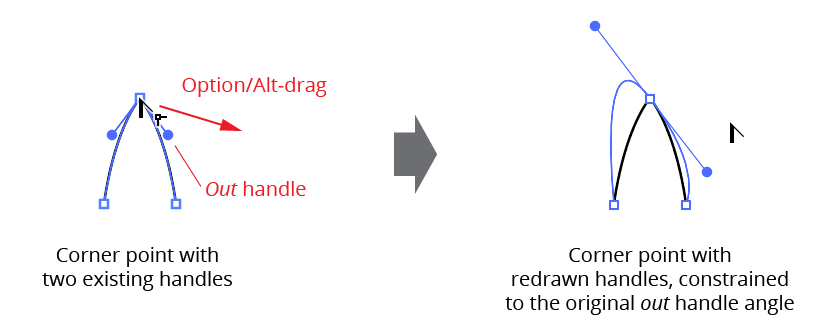
PathScribe Extend one or two handles
When only one handle already exists, the “original” angle for a smooth point is the angle of the existing handle plus 180°. For corner points, or when no handles exist, the “original” angle is set to the tangent angle of the path at the point.
L: Toggles Line Constraining. When enabled, the motion of the dragged anchor point is constrained to positions that lie along the previous/next path segments, or their extensions. When a single anchor point is dragged, the opposing handle (if any) on the segment over which the point is being dragged is adjusted to keep the curve from changing. Previews of the extensions for curved beziers are annotated.
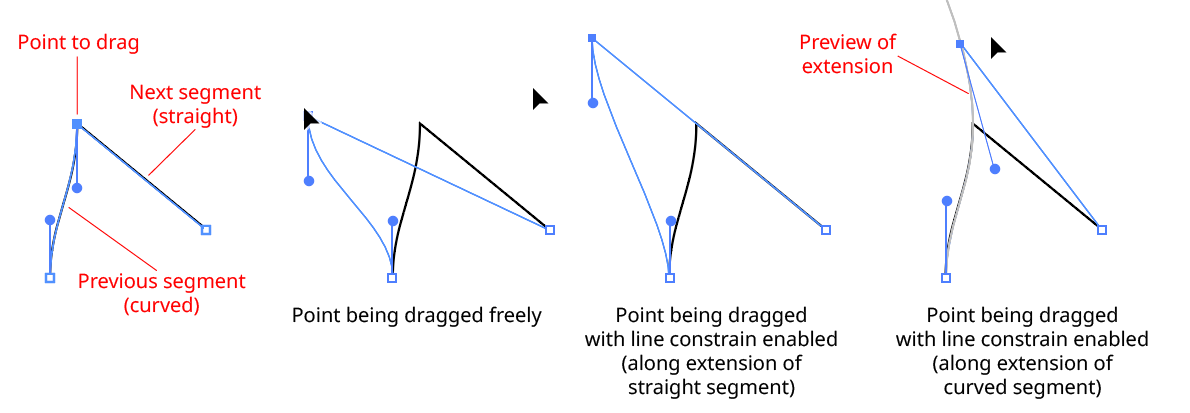
PathScribe Point Drag Line Constraining
Path Segment Operations
Clicking
Clicking on a path segment without any modifier keys selects it, causing its handles (in handle at one end, out handle at the other end) to become visible (if they exist), and hiding other handles on the same path. Other paths are not affected: if they were fully- or partially-selected, they remain so. Marqueeing over a segment acts in the same way as clicking on it.
If the Show All Handles on Selected Paths preference is enabled, clicking on a path segment selects all of the segments on the path (thus causing their handles to become visible).
Adding one more modifier keys while clicking a path segment changes or adds functionality:
Shift: As with a point,
Shift-clickingon a path segment will, by default, simply add or remove the path segment from the selection (unless the Show All Handles on Selected Paths preference is enabled, in which caseShift-clickingdoes nothing). However, by enabling the preference Shift-Clicking Equalizes Handle Lengths, it instead equalizes the path segment’s handle lengths (handle angles are not affected). How the length is calculated depends on where you click along the length of the segment.Shift-clickingin the middle third will average the handle’s lengths together, whileShift-clickingin either of the outer thirds will change the length of the nearest handle to match the opposite one:

PathScribe Shift-clicking on path will add or remove segment from selection
Option/Alt: By default,
Option/Alt-clickingon a path segment will add a new smooth point to the path at the clicked point. The cursor shows a “plus” sign. If the preference Snap to Tangencies is enabled, the cursor will snap to vertical, horizontal and diagonal tangencies on the path segment (the constrain angle is honored). A red guide will appear when the cursor is snapping to show you the tangent direction:

PathScribe path add point
Additionally, you can choose to highlight all of the tangencies on the current path segment with a small magenta dot by enabling the Highlight Tangencies preference:
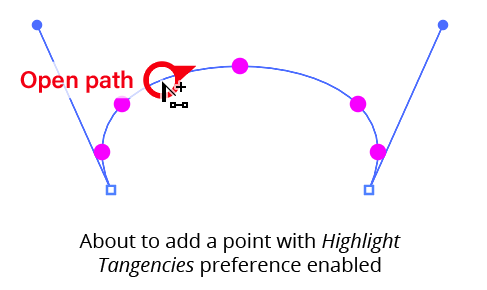
PathScribe add point highlight tangencies on the current path
If the Option/Alt-Clicking Adds New Point to Path preference is disabled, then Option/Alt-clicking a path selects all of the path’s segments, thereby making all of the handles on the entire path visible. You can do this even while in Multi-Handle Mode. Other paths are not affected.
Shift+Option/Alt: By default,
Shift+Option/Alt-clickingon a path segment toggles the visibility state of all the handles on the entire path. If a path has only some of its handles visible,Shift+Option/Alt-clickingon the path will hide them. However, by enabling the preference Shift-Clicking Equalizes Handle Lengths, it instead will retract or extend new handles. If the handle nearest the click exists, both handles will be retracted; otherwise, new handles are created where they don’t already exist. In both cases, adjacent path segments are not affected.
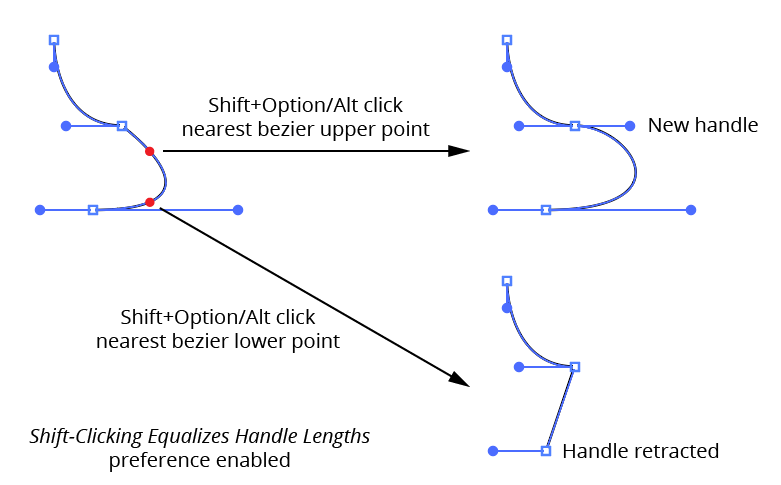
PathScribe Shift+Option-clicking on path toggles visibility state
Dragging
Dragging a path segment reshapes it, similarly to the Direct Selection tool. The closer the initial mouse-down is to one point, the more that point’s handle movement is affected by the cursor movement and the less the other handle is affected. Starting the drag midway along the path between the points affects both handles equally. If the Keep Path Under Cursor When Dragging preference is disabled, handles are still moved relative to the initial click location, but the path will not necessarily pass through the cursor position.
If either of the segment’s handles does not exist at the start of the drag, new ones will be created. Their initial location is controlled by PathScribe’s Smoothing Ratio preference.
Normally, adjacent segments will also be affected when you drag a segment if its endpoints are smooth points, since the opposing handles must change angles to remain 180° away from the moved handles. If you’d rather only affect the dragged segment in isolation, you can enable the preference Convert Smooth Points to Corner Points When Dragging Path Segments:
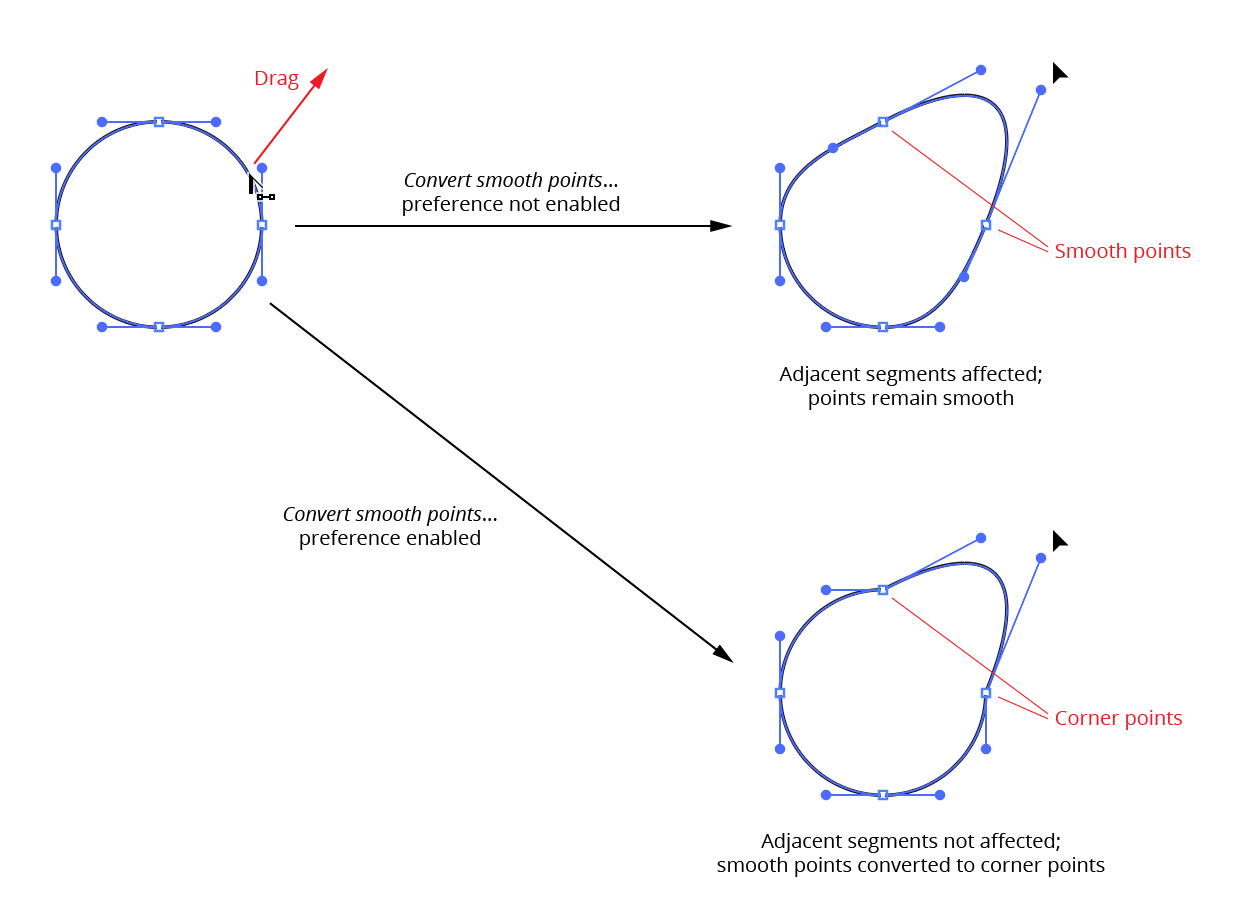
PathScribe Path drag break
This preference can also be changed on the fly by pressing the D key.
Note: When you are using Recognize Connector Points, segments with connector points at one or both ends are affected differently by drags, since a connector point can have only one handle at a fixed angle; see Connector Points).
While dragging, there are various keys which can be pressed to perform additional functions:
Shift: Reshapes the path segment while keeping it symmetric. Symmetric means that both handles are of the same length and are at the same angle to the imaginary line running through the endpoints of the path segment.
Shift-draggingfrom the middle third of a path segment will additionally constrain the handle angle to be perpendicular to this imaginary line:

PathScribe path drag symmetrical handles
Except for middle-third Shift-dragging, if you release the Shift key (or if you started dragging without it) and later hold it down, the curve will become symmetric using the lengths and angles of the handles as they exist at that moment.
Option/Alt: Constrains the angles of the handles to their original values (±180°). If you have the Option/ Alt-Clicking Adds New Point to Path preference enabled, you must hold down
Option/Altafter you hold down the mouse button, or you will inadvertently add a point to the path. But even if you begin to drag withoutOption/Alt, holding it down afterwards will reset the angles of the handles to the angles they had when you originally moused down on the path. Note: If the initial mouse-down was close to one of the ends of the segment, the segment shape will probably be very sensitive to movement of the cursor. You can gain better control of the final segment shape by using slow-drag in this situation.Shift+Option/Alt:
Shift+Option/Alt-dragginga path segment reshapes it with the following constraints: the handle lengths are kept equalized, and the handle angles are constrained to their original values. As withOption/Alt-dragging, handle angles will be set to the original angles unlessShiftwas held down by itself first (which will have made the curve symmetric). This allows you to first symmetrize a curve until the handles are at the angle you like, and then lengthen or shorten them without losing the symmetry. WhenShiftandOption/Altare both held down before you drag, neither the Shift-clicking Equalizes Handle Lengths nor the Option/Alt-Clicking Adds New Point to Path preferences apply.D: Toggles the current Convert Smooth Points to Corner Points When Dragging Path Segments preference. The preference reverts to its original value when the mouse button is released.
R: Retracts the handles of the path segment being dragged.
S: Immediately converts the path segments endpoints to smooth type points.
T: Enables “Tangent constraining.” In this mode, the angle of the path segment as it passes through the cursor position is kept constant, regardless of where the cursor is dragged. To achieve this, the segment’s handles are adjusted in a different manner from a normal drag.
Marqueeing Operations
Starting at an area with nothing under the cursor, you can click-and-drag with the PathScribe tool (“marqueeing”) to draw out a rectangle that selects anchor points and path segments that fall within or intersect it, like the Direct Selection tool. Although points and segments can also be selected by clicking on them, multiple handles can only be selected by marqueeing. Additionally, handles take priority over points and segments (unless Option/Alt is held down, see below); i.e., PathScribe will always look for and select handles before selecting points or segments. You can cancel a marquee in progress by pressing the Esc key.
Holding down the Space bar when marquee selecting repositions the entire marquee rectangle.
Holding down Shift when marquee selecting has the same effect as when selecting with the native selection tools: if whatever would be selected is not yet selected, it is added to the current selection, otherwise it is subtracted from the current selection.
Holding down Option/Alt when marquee selecting forces PathScribe to ignore handles and only select points or segments. (If no points are selected, but at least one segment is, all of the path’s segments will be selected, thereby showing all the path’s handles.)
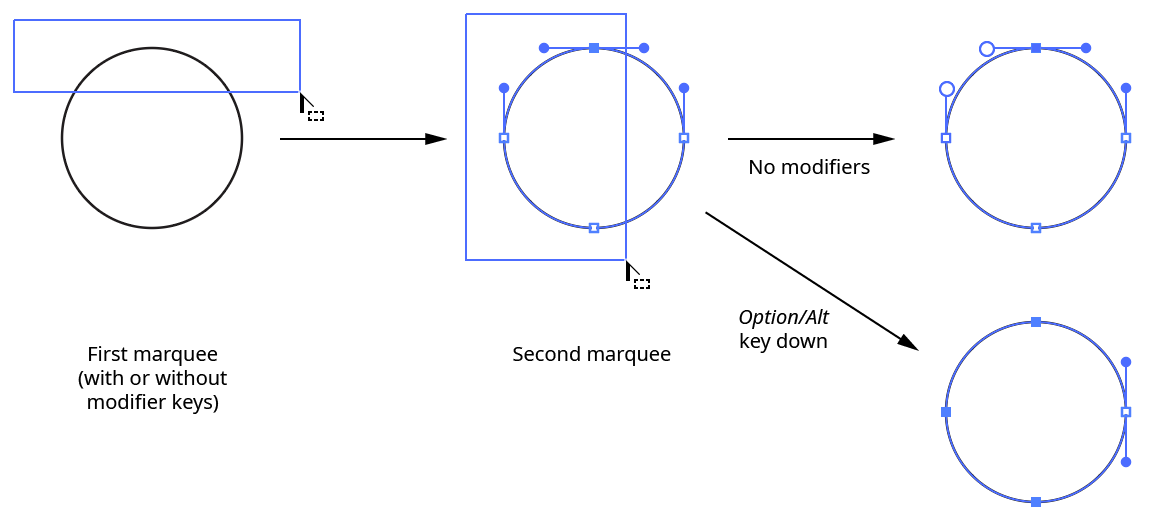
PathScribe marqueeing points
Pressing the S key when marqueeing toggles Ignore Segments mode. In this mode, segments will never be selected, even if they intersect the marquee, and only anchor points will be selected. Note that this mode does not exist for the Direct Selection tool, which always selects both anchor points and segments.
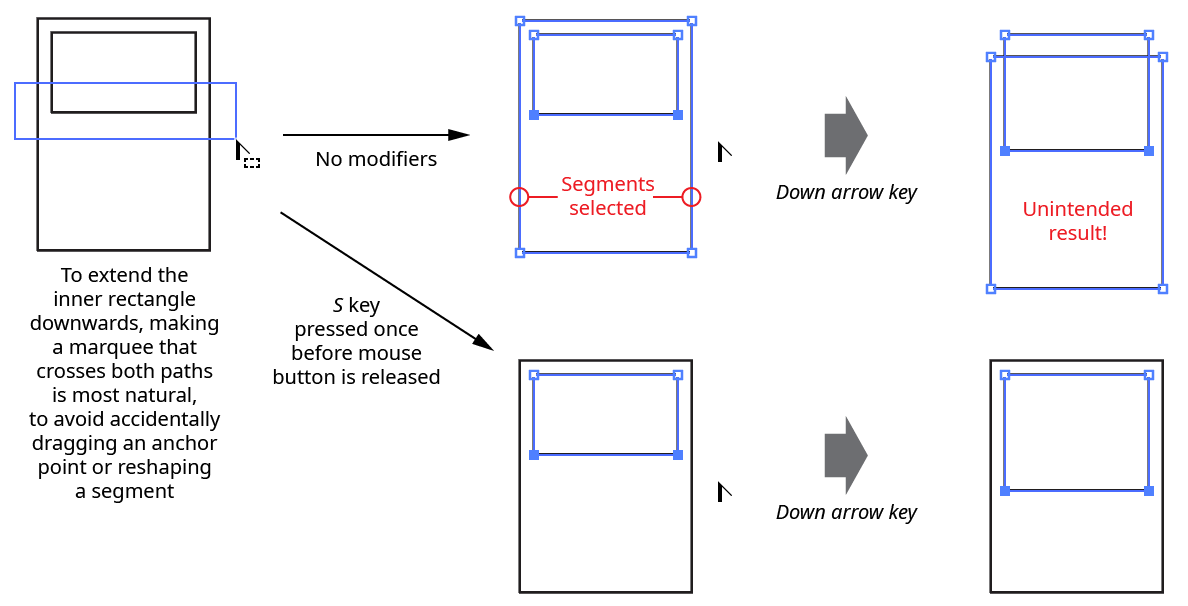
PathScribe marqueeing - ignore segments
If ghost handles are visible, pressing the G key when marqueeing will convert the ghost handles that are within the marquee into real handles (after the mouse button is released):

PathScribe marqueeing - Convert ghost handles
Shift+Option/Alt-clicking on an empty area of the document is a shortcut which will select all the handles of any selected points and enter Multi-Handle mode.
Connector Points
When the Recognize Connector Points preference is enabled, PathScribe can recognize and work with connector points: points that act as transitions between straight segments and curved segments.
A connector point:
Can be either a smooth or corner point, but not an endpoint of an open path;
Must have a single handle that faces directly away from another point (the base point);
Must be adjacent (on its non-handle side) to a segment with no handles
Additionally, for PathScribe to recognize a point as a connector, its handle must be lined up with the straight segment. The amount that its handle can be off and still qualify as a connector is called the angle threshold. It has a default value is 5° but can be set in the preferences dialog.
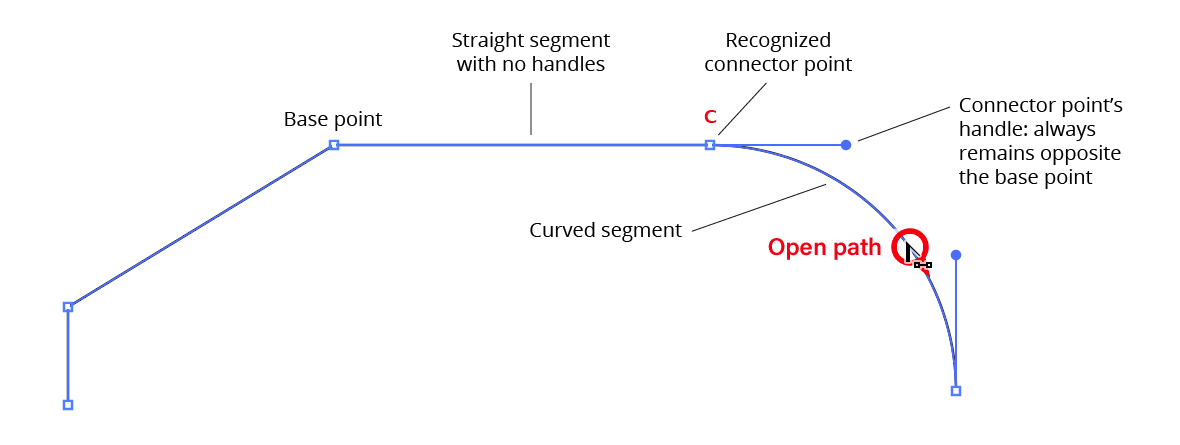
PathScribe Recognize a point as a connector
Hovering the cursor over a path will identify all of the path’s recognized connector points by drawing a small “C” above them. The color of the “C” indicates whether a connector is within the angle threshold but not perfectly lined up (gray) or aligned precisely (red):
PathScribe connector point indicator
You can use the PathScribe panel to align all recognized connector points on selected paths. Also, nearly all clicks and drags with the PathScribe tool on a connector point, its handle, the segments next to it, or the points adjacent to it, will automatically align (if not already), and keep aligned, the connector point’s handle. (Exceptions include Multi-Handle drags and Shift+Option/Alt-clicks that retract or extend new handles.) When a connector point is being automatically aligned during an edit, a red “C” will appear above it. If the edit removes the connector’s points handle (such as dragging its handle back until it is of zero length), the “C” will disappear.
Since other Illustrator tools will not see connector points any differently from non-connector points, any geometry edits other than those that affect the entire path (such as moving, rotating, and scaling) should only be done using the PathScribe tool, or any connector point’s handles may be disturbed.
PathScribe Panel
The PathScribe panel allows you to numerically edit anchor points and their handles, as well as perform certain operations on one or more points or paths. Its flyout menu also allows you to select handles and points, perform certain path operations, change the layout of the panel, and bring up the Preferences dialog. The panel has two different appearances depending on whether multiple handles are selected. You can show or hide the PathScribe panel using the menu command Window > Astute Graphics > PathScribe.
Point Mode
When no handles are selected, the panel appears in Point Mode:
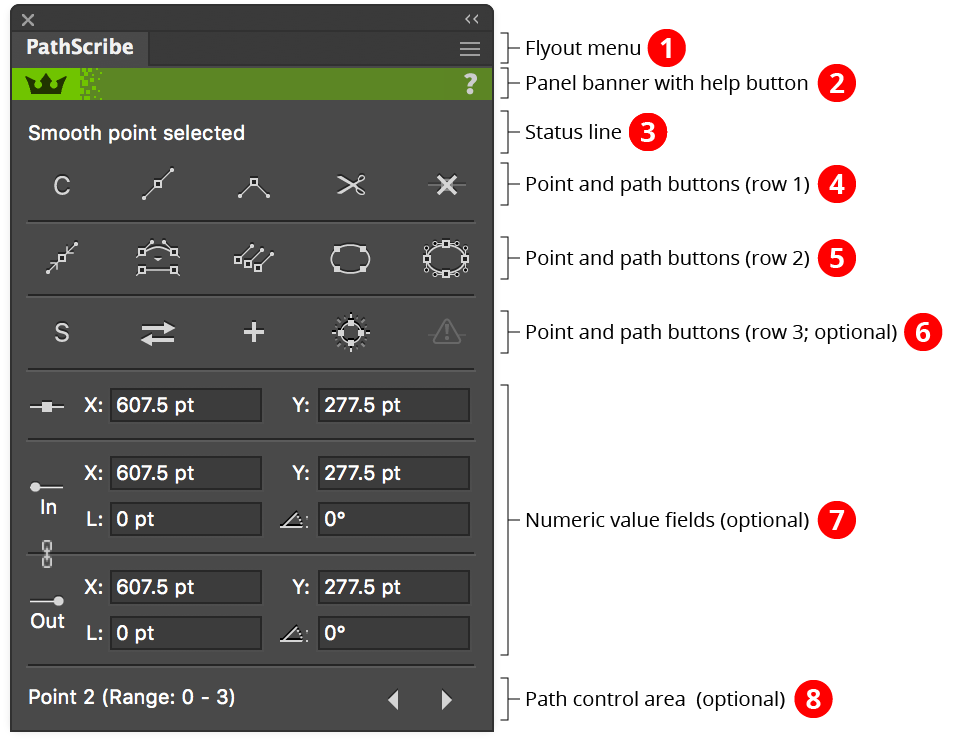
PathScribe Panel point mode
1. Flyout menu
See PathScribe Panel: Flyout Menu.
2. Panel banner
The help button on the right opens the help documentation in the Astute Manager. If this does not automatically appear, please ensure your Astute Manager is running first.
Click on the other area of the color bar to activate the PathScribe tool. This is a quick method of locating the tool within the default Advanced toolbar or a custom toolbar.
3. Status Line
Shows information about the current selection, for example “7 points selected”. When exactly two anchor points are selected, the status line shows the distance between them, and displays a small button which allows you to average the points’ positions, to make them coincident:

PathScribe Panel two point average
Option/Alt-clicking on the status line when showing the distance between two points will copy the distance value to the system clipboard.
If the third row of buttons is hidden, the status line also contains a redundant point indicator/button (see below). Finally, the status line will also indicate what you are editing during a drag operation.
4. Point and Path Buttons (row 1)
a. Connector Point Recognition Button: Toggles Connector Point recognition. When the “C” symbol is dim, connector point recognition is off and the PathScribe tool will not afford any special handling to points which qualify as connectors.
b. Smooth Point Button: Changes all selected anchor points to smooth points. By default, this also adds new handles to these points so they all have two opposed handles. This can be very useful for creating a path that runs smoothly through the points:

PathScribe smooth point button example
The algorithm that PathScribe uses to create new handles is as follows: If a point already has one handle, its second handle is created by mirroring the existing handle. If a point has no handles, the new handle angle is calculated by bisecting the angle formed by the previous point, the point in question, and the next point, and taking its perpendicular. The new handle length is calculated by taking the lesser of the distances from the point in question to the previous and next points, and multiplying by the smoothing ratio (set in the Preferences dialog). Handles of endpoints of open paths, if created, are adjusted to aim towards the next/previous handle.
To change selected anchor points to smooth points without adding handles, hold down Option/Alt when clicking the button.
c. Corner Point Button: Changes all selected anchor points to corner points. No handles are created or changed.
d. Split Path Button: Splits the path(s) at the selected points, just as clicking on them with the Scissors tool would. Both new endpoints get a copy of the original point’s handles.
e. Smart Remove Point Button: Removes the selected point(s) from the path while attempting to keep the curve as close as possible to its original shape. This is achieved by adjusting the lengths (but not angles) of the handles on either side of the removed points. To remove points without handle adjustment in the manner of the Delete Anchor Point tool, hold down Option/Alt while clicking the button.
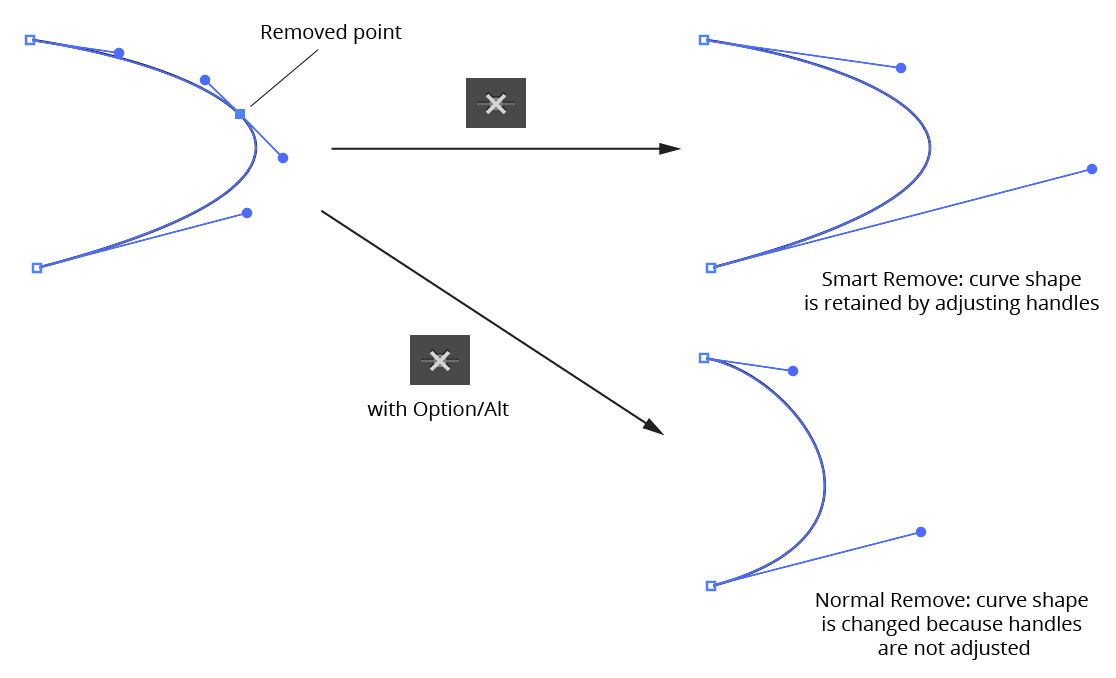
PathScribe Panel smart point remove
When anchor points are selected, you can use the keypress assigned in the Keyboard Shortcuts dialog for “Increase Diameter” (by default, the right bracket key – ]) as a shortcut for the Smart Remove Point button.
When Shift is held down while the button is clicked, PathScribe removes straight segment corners. To utilize this function, two or more adjacent anchor points must be selected, the first and last of which are adjacent to a straight segment (or at the end of an open path); the segments do not necessarily have to form a “nice” corner. The selected anchor points are replaced by a single anchor point at the intersection of the outer straight segments:
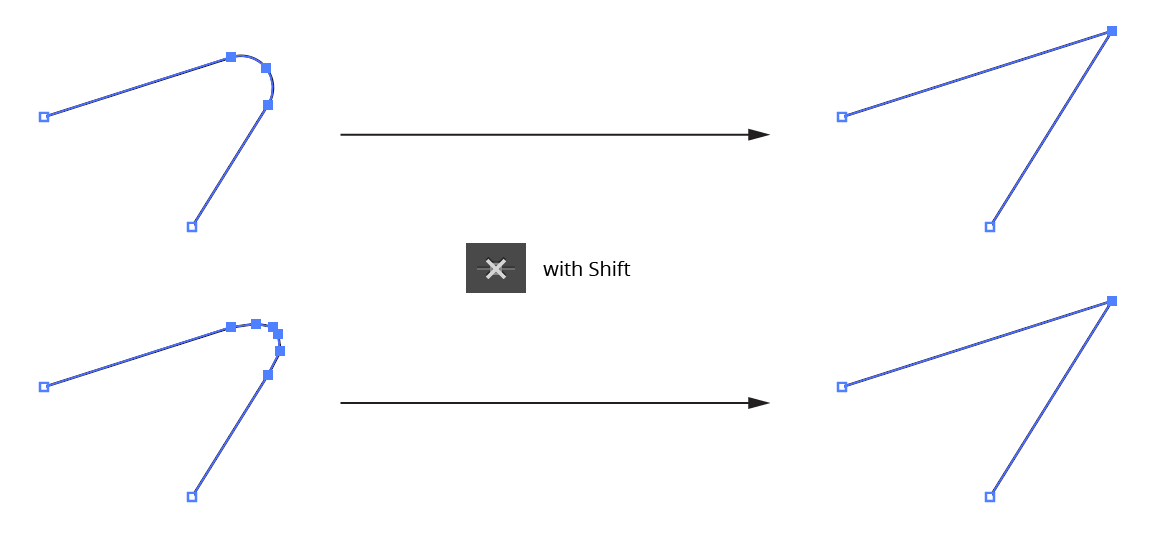
PathScribe removes handles
5. Point and Path Buttons (row 2)
a. Retract Handles Button: Retracts all of the handles on the selected point(s). Point types are not changed. Holding down Option/Alt while clicking the button activates an alternate function: it swaps the positions of the in and out handles on each selected point.
b. Retract Segment Handles Button: Retracts handles from all selected path segments. Point types are not changed.

PathScribe Panel remove handles from segments
c. Show Handles Button: All paths or compound path subpaths which are at least partly selected will have all handles made visible (note that this deselects all anchor points and instead selects all path segments).
d. Select Path Points Button: Selects all points on all paths which are at least partially selected.
e. Select All Handles Button: Selects all handles on all paths which are at least partially selected; PathScribe then enters Multi-Handle mode.
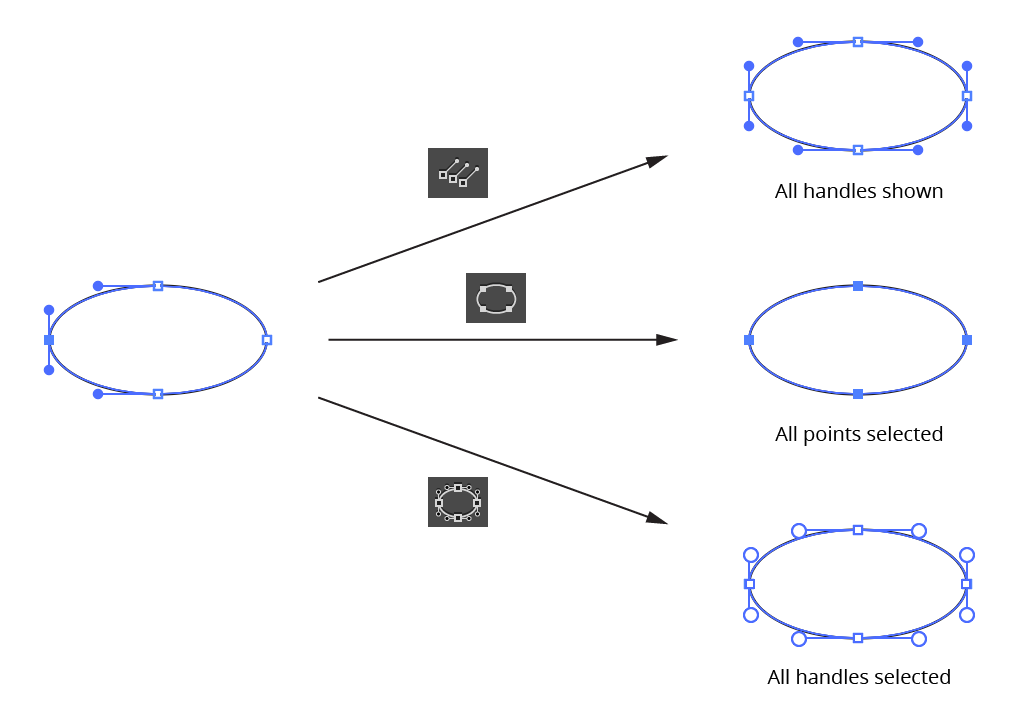
PathScribe second row icons
6. Point and Path Buttons (row 3)
This row can be shown or hidden using the PathScribe panel flyout menu.
a. Smart Smooth Button: Enables or disables “Smart Smooth”, a feature of the PathScribe tool which allows you to convert a corner point into a smooth point simply by dragging one of the point’s handles to be opposite the other (within a certain tolerance). A small red “S” annotation is drawn over points which are being aligned this way. The threshold angle value can be specified in the Preferences dialog.

PathScribe panel smart smooth
b. Reverse Path Direction Button: Reverses the direction of any selected paths or subpaths. This will generally only produce a visible change to the artwork if a subpath of a filled compound path is reversed or if the path is being stroked by an asymmetric brush:
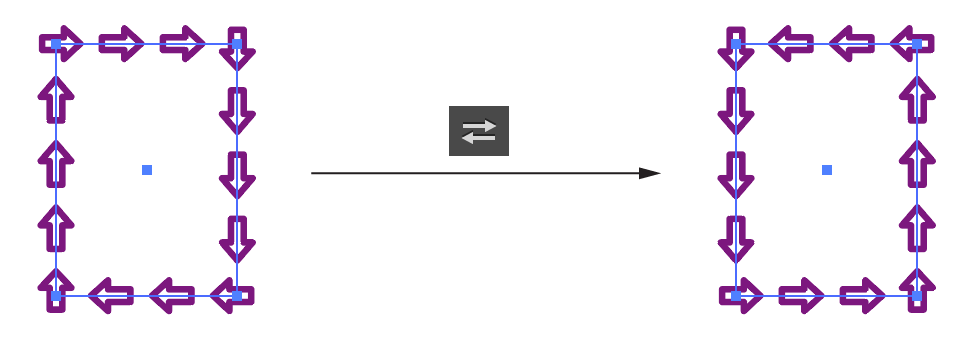
PathScribe Reverse Path Direction Button
When the third row of buttons is hidden, the “Reverse Path” command can still be accessed through the PathScribe panel flyout menu (see below).
c. Add Points to Selected Segments Button: Adds anchors points to every selected segment of every selected path. The number of points added and algorithm used to add them are taken from the last-used settings. To open the dialog which enables you to edit these values, Option/Alt-click on the button.
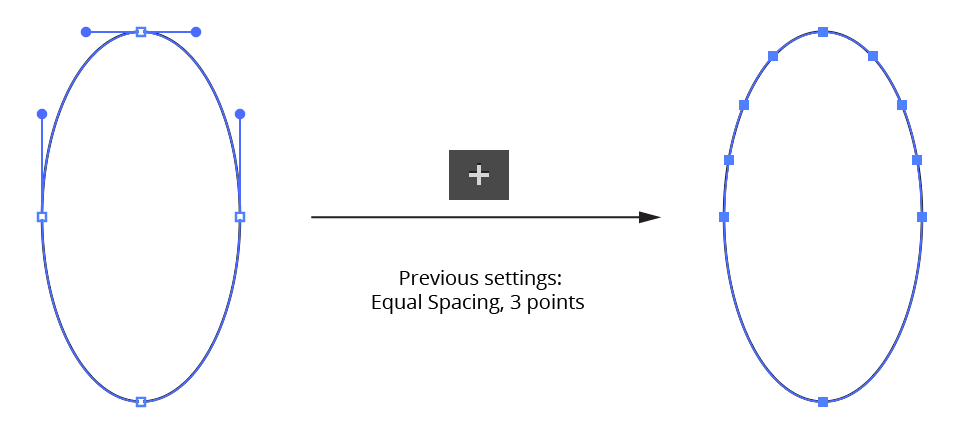
PathScribe Add Points to Selected Segments Button
When the third row of buttons is hidden, the “Add Points” command can still be accessed through the PathScribe panel flyout menu (see below).
d. Move Points to Tangencies Button: Moves anchor points on the selected paths to positions along the path where the angle of the path as it passes through the anchor point is tangent to the horizontal or vertical axes (taking into account the current constrain angle).

PathScribe Move Points to Tangencies Button
Holding down Option/Alt when clicking the button changes its functionality: new anchor points are placed at the tangent positions, but the existing anchor points are retained.
Holding down Shift when clicking the button also changes its functionality: Only selected points are moved to tangencies.
When the third row of buttons is hidden, the “Move Points” command can still be accessed through the PathScribe panel flyout menu (see below).
e. Remove Redundant Points Button: Removes all redundant points from all selected paths. If the button is disabled (dim), no redundant points exist. A redundant point, also known as a doubled point, is defined as the latter of two consecutive anchor points on a path that have exactly the same X and Y coordinates and don’t have handles in the (zero-length) segment between them. They are often created after using the PathFinder functions or after using Object > Path > Outline Stroke, and despite not changing the shape of the path, can cause problems when performing additional functions such as offsetting. You can highlight the locations of redundant points when using the PathScribe tool by enabling the corresponding preference (see PathScribe Preferences).
When the third row of buttons is hidden, the button will appear on the right side of the top status line. Due to space considerations, the icon uses a small exclamation point rather than the full icon:

PathScribe Remove Redundant Points Button
7. Numeric Value Fields
This area can be shown or hidden using the PathScribe panel flyout menu.

PathScribe Numeric Value Fields
When an anchor point is selected, the numeric value fields becomes active, reflecting the X and Y coordinates of the anchor point and the coordinates, lengths and angles of its two direction handles. You can make edits to any of the fields by simply typing in a new value and pressing Return/Enter or Tab. Like other numerical entry fields in Illustrator, you can use any units you wish (except in the angle fields) and one math operator.
The linked handles icon appears when editing a smooth point, as a reminder that edits to the coordinates or angle of one handle will also affect the other handle (if it exists).
You can specify the number of digits that are displayed after the decimal point through PathScribe’s Precision preference.
When more than one anchor point is selected, fields which are blank indicate that multiple values are present. You can still type a new value into the field, thereby assigning it to all selected anchor points/ handles. Or, for the anchor point fields, you can Shift-click on the anchor point icon to average all values in both fields; or Shift-click on the “X:” or “Y:” labels to average only the corresponding value.
When the Show Anchor Point Coordinate Ranges preference is enabled, mixed values will be instead displayed in the anchor point coordinate fields as a value (in blue) representing the difference between the highest value and the lowest value:
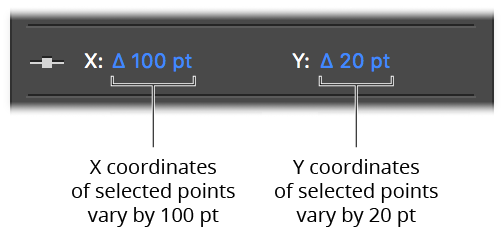
PathScribe Coordinates of points
Clicking on the range will allow you to enter a new value, just as with the preference disabled. Values which are too small to display with the current precision are displayed using scientific notation, e.g. 3.12E-06, where “E-06” means “×10–6” (one-millionth).
8. Path Control Area
This area can be shown or hidden using the PathScribe panel flyout menu. In Point Mode, the path control area has three different appearances:
a. When the selection consists of more than one path, the path control area shows the total number of selected paths and the number of each type (closed, open, or single-point). Each subpath of a compound path is reported separately.

PathScribe Panel Path Control Area multiple paths
b. When the selection consists of a single path, and either multiple points or no points on the path are selected, the status line shows the type of path and a Select Point 0 button. Because Illustrator numbers points starting at zero and continuing consecutively in the direction of the path, clicking the button will therefore select the first point on the path. By default, the selected point will be briefly highlighted with a small magenta dot to make it easier to locate. If the Highlight Panel-Selected Points preference is disabled, you can still highlight the point on a use-by-use basis by holding down Option/Alt when clicking the button.

PathScribe Panel Point Control Area Show Point
c. When the selection consists of a single point on a single path, the path control area shows the index of the point, the range of indices on the path, and two buttons that let you change the point that is selected. To move to (i.e., select) the previous or next point on the path, click the Previous point or Next point button. Clicking the Next point button or Previous point button while the last point of an open path is selected will wrap around to the other end.
Holding down Shift while clicking the Next point or Previous point buttons will move ahead or back 10 anchor points (if the path has more than 10 points).

PathScribe PCA Previous Next buttons
Again, the selected point will be briefly highlighted by default.
Multi-Handle Mode
If one or more handles are selected, the panel switches to Multi-Handle Mode:
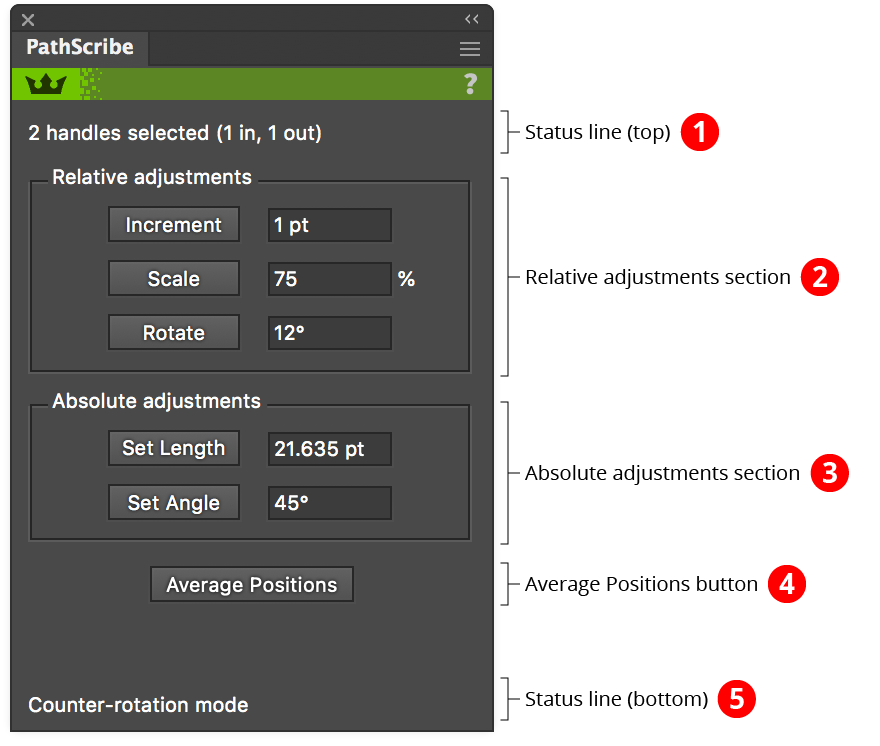
PathScribe Multi-Handle Mode
1. Status Line (top)
In Multi-Handle Mode, the top status line will tell you how many handles you have selected, and how many are of each type (in and out).
2. Relative Adjustments Section
The relative adjustment buttons (Increment, Scale, and Rotate) transform selected handles relative to their current lengths and/or angles. The values you enter are retained from use to use. You can either enter a value and click on the button next to it, or enter a value and type Return/ Enter . If you click the button, you can simultaneously hold down Shift to multiply the effect of the transformation by the shift multiplier, which is set in the preferences. You can also hold down the Option/Alt key to reverse the effect of the transformation.
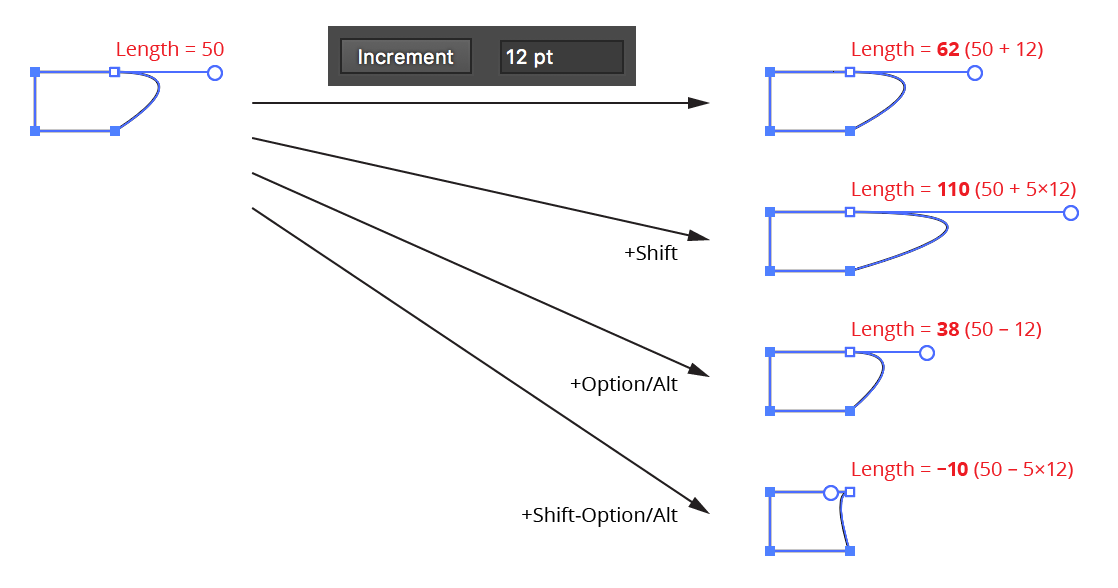
PathScribe Panel Mutlihandle Increment
When using Option/Alt with the Scale button, the reciprocal of the scale value is used (e.g. if a handle is scaled 80%, Option/Alt will change the scale to (1/0.80) = 1.35 = 125%).
3. Absolute Adjustments Section
The absolute adjustment buttons (Set Length and Set Angle) transform handles using the values in the fields adjacent to them. As with relative adjustments, the Shift and Option/Alt keys can be held while clicking the buttons to scale or invert the transformation. However, the keys have a slightly different meaning with the Set Angle button: Shift + Set Angle reflects the handle across the horizontal axis passing through the point; Option/Alt + Set Angle reflects the handle across the vertical axis. Shift+Option/Alt + Set Angle reflects the handle across both axes (which is the same as rotating it 180°).
When a single handle is selected, its length and angle values are copied into the value fields of the absolute adjustments section. This enables you to easily “pick up” a handle’s attributes and copy it to one or more other handles. To do this, select only the handle whose attribute(s) you wish to copy. Then, holding down Shift, marquee-select the other handles and click the appropriate buttons to duplicate either the length or angle:
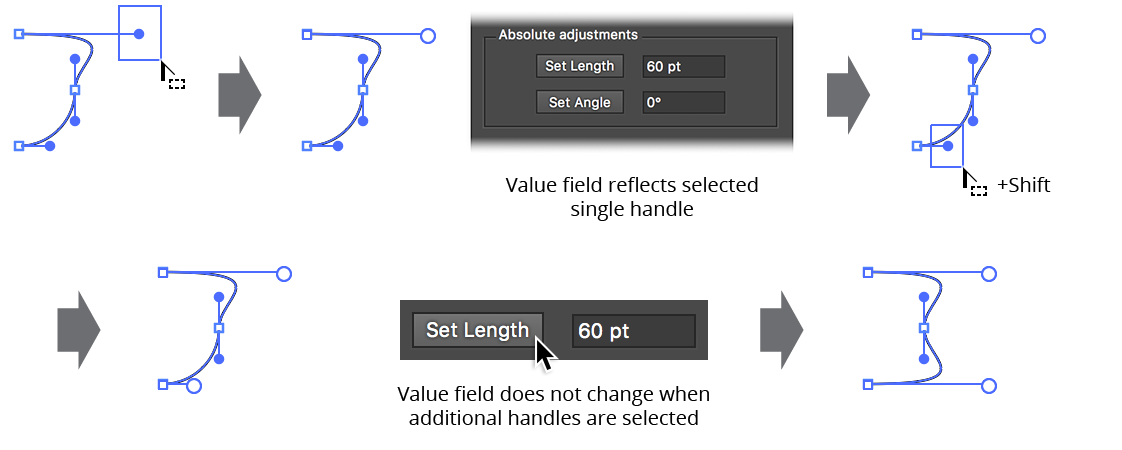
PathScribe Panel handle length copying
You can also hold down the Command/Ctrl key when clicking the Set Length button to change the length to zero (retract the handles). Or, even easier, use the keypress assigned in the Keyboard Shortcuts dialog for “Increase Diameter” (by default, the right bracket key – ]).
4. Average Positions Button
The Average Positions button moves all selected handles to the position whose X coordinate is an average of all the selected handle X coordinates and whose Y coordinate is an average of all the selected handle Y coordinates. If the selected handles are already coincident (all at the same position), the button will be disabled.

PathScribe Panel handle averaging
5. Status Line (bottom)
When the mouse button is up, the bottom status line that tells you which multi-handle drag mode is active. When the mouse button is down, it gives information about the current operation and any keypresses which can affect it. Also, when you are constraining multiple handles (by holding down the Option/Alt key while dragging), the bottom status line will indicate whether you are using the proportional method of handle extension or the absolute method.
PathScribe Panel Flyout Menu
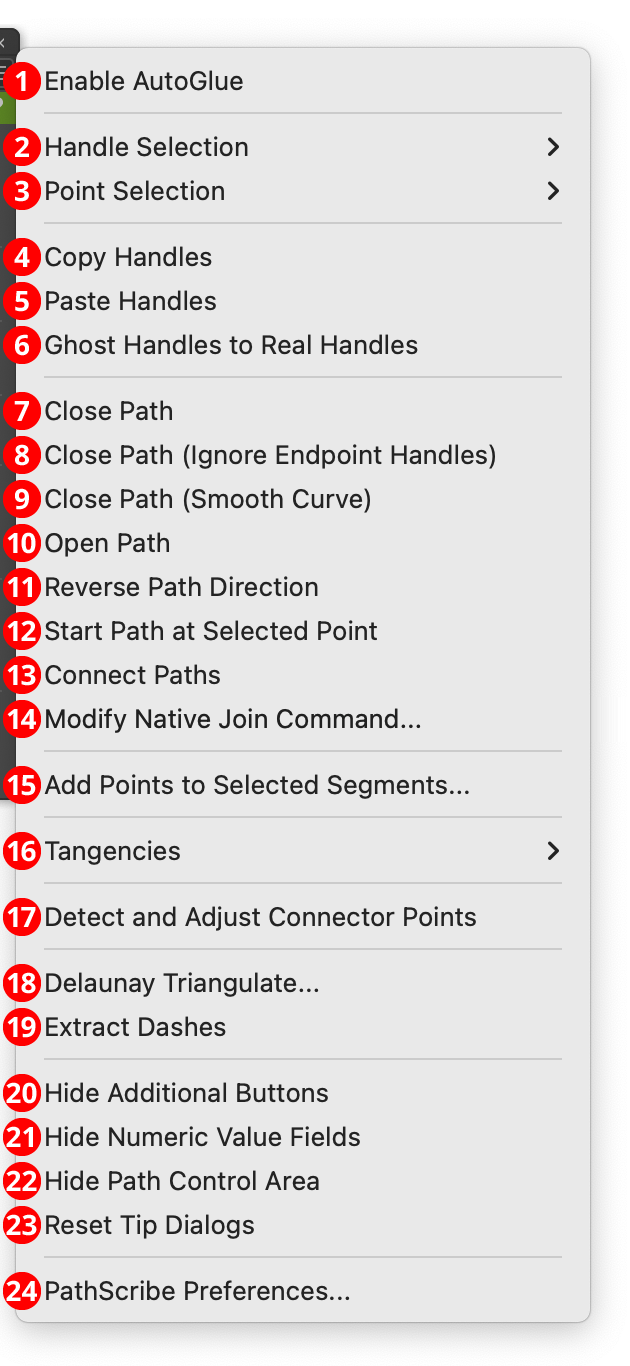
PathScribe Panel Flyout Menu
The PathScribe panel flyout menu and related submenus are shown here with all items enabled; in actual use, items which are not applicable in the current context would be disabled. Additionally, some of the menu items may change their wording slightly depending on context. For example, the Hide Additional Buttons menu item will say Show Additional Buttons if the buttons are already hidden.
1. Enable/Disable AutoGlue
AutoGlue is a feature of the PathScribe tool that enables anchor points (and/or handles) that lie directly on top of each other to be treated as if they were temporarily “glued” together, thereby allowing them to be moved together even if they aren’t all selected. The feature is disabled by default. When first enabled, a tip dialog with a short summary will be displayed.
Normally, dragging an anchor point without marquee-selecting multiple points will only affect the topmost path, even if other anchor points sit at the same position:

PathScribe Example Without AutoGlue Enabled
But when AutoGlue is enabled, all anchor points with the same coordinates will act as though they were “glued” together, and will move as one:

PathScribe Example With AutoGlue Enabled
AutoGlue also works on entire path segments: if two paths share a segment (both the anchor points at each end and their inward-facing handles, if any, all lie on top of each other), then editing the path segment (reshaping, dragging out or converting ghost handles, and adding or deleting points) with AutoGlue enabled will simultaneously edit the “glued” segments:

PathScribe AutoGlue Example Reshaping Segments
AutoGlue is especially useful when working with artwork created with generative AI, since this type of art is often composed of non-overlapping paths with common edges. A tolerance value, used to determine whether coordinates are considered identical, is specifiable in the PathScribe preferences.
2. Handle Selection submenu
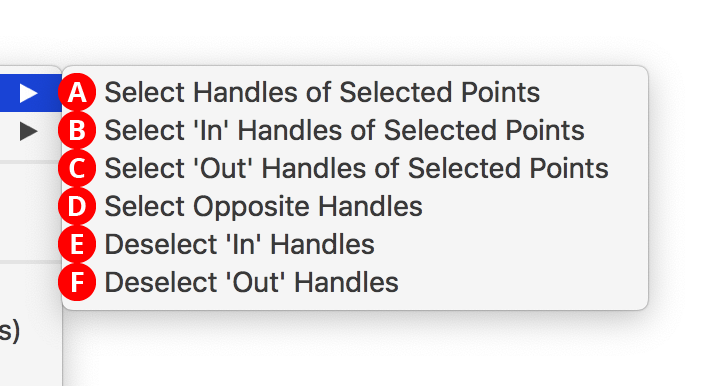
PathScribe Panel Flyout submenu
A. Select Handles of Selected Points
When there are one or more points selected, selects all of the handles on all of the selected points and enters Multi-Handle mode. The PathScribe tool will automatically be selected afterwards if it is not already so you can work with the selected handles.
Shift+Option/Alt-clicking on an empty area of the canvas with the PathScribe tool does the same thing as choosing Select Handles of Selected Points but is much easier.
B. Select ‘In’ Handles of Selected Points
C. Select ‘Out’ Handles of Selected Points
Same as A., but only selects handles of the specified type.
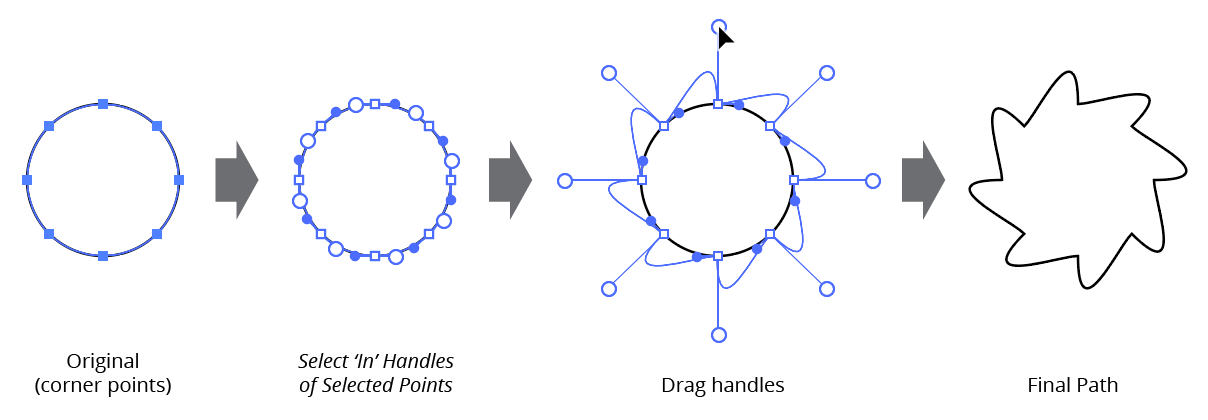
Select in and out handles PathScribe
D. Select Opposite Handles
[Enabled only in Multi-Handle mode] Selects an anchor point’s in handle if only the out handle is selected, and its out handles if only the in handle is selected. If both handles were originally selected, they both remain selected.
E. Deselect ‘In’ Handles
F. Deselect ‘Out’ Handles
[Enabled only in Multi-Handle mode] Removes all handles of the specified type from the handle selection.
3. Point Selection submenu
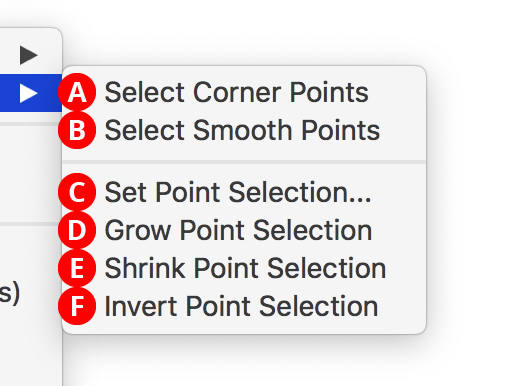
PathScribe point selection submenu
A. Select Corner Points
B. Select Smooth Points
Selects all anchor points of the specified type on all selected paths.
C. Set Point Selection...
Allows you to select points on selected paths by position, using the dialog that comes up:

Point Selection PathScribe Skip Steps
The “Initial Skip” value specifies the number of anchor points to leave unselected, starting at point 0 of the path. Thereafter, the selection pattern is specified by the “Select” and “Skip” values, which specify the number of points in a row to select followed by the number to leave unselected. As the values are changed, the points which will be selected are dynamically highlighted on the artboard using magenta dots:

Point Selection PathScribe Skip Steps
You can bypass the dialog and use the values from the previous application of Set Point Selection by holding down Shift while choosing the menu item. The Reset button changes Initial Skip to 0, Select to 1, and Skip to 1 (i.e., every other point starting with the first). Holding down Shift while clicking the Reset button does the same except the Initial Skip is set to 1.
D. Grow Point Selection
Grows the current point selection by selecting one additional anchor point on either side of all points which are already selected.

PathScribe Grow Point Selection
You can use the keypress assigned in the Keyboard Shortcuts dialog for “Decrease Diameter” (by default, the left bracket key – [) as a shortcut for growing the point selection.
E. Shrink Point Selection
Shrinks the current point selection by deselecting all anchor points which already have an unselected point on either side of them, or are on the end of an open path.
F. Invert Point Selection
Inverts the current point selection by switching unselected anchor points for selected points. Paths which were completely unselected to start remain unselected.
4. Copy Handles
Lets you copy the direction and length of a single handle, or, as long as they are the in and out handles of a single point, two handles. When both handles of a point are copied, the point type (corner or smooth) is also retained. The menu item is available when a single point is selected, or in Multi-Handle mode when one handle or the in and out handles of a single point are selected. The PathScribe tool does not need to be active when copying both handles from a single point. Copied handle and point type data is stored in an internal clipboard which is cleared only when Illustrator is quit.
5. Paste Handles
Lets you change both handles on any selected points (or specific, selected handles when in Multi-Handle mode) to match the handle(s) that were previously copied with Copy Handles. You can paste to multiple points on multiple paths, and the PathScribe tool does not need to be active. If a single handle was copied, then its data will be pasted to any selected handles, regardless of type (in or out), and any affected points will become corner points. If both handles of a single point were previously copied, then selected in handles will receive the copied in handle’s data, and selected out handles will receive the copied out handle’s data. If a point gets two new handles from two handles that were previously copied, then the previously-copied point type (smooth or corner) is also applied to it.

PathScribe copy paste handles
6. Ghost Handles to Real Handles
When one or more ghost handles are visible, converts them to real handles.
7. Close Path
8. Close Path (Ignore Endpoint Handles)
9. Close Path (Smooth Curve)
All these menu items close selected open paths; they differ in how handles for the new segment are created. Close Path honors existing handles; Close Path (Ignore Endpoint Handles) always results in a straight new segment without handles; Close Path (Smooth Curve) creates new handles for the segment such that it blends smoothly with the existing path segments:
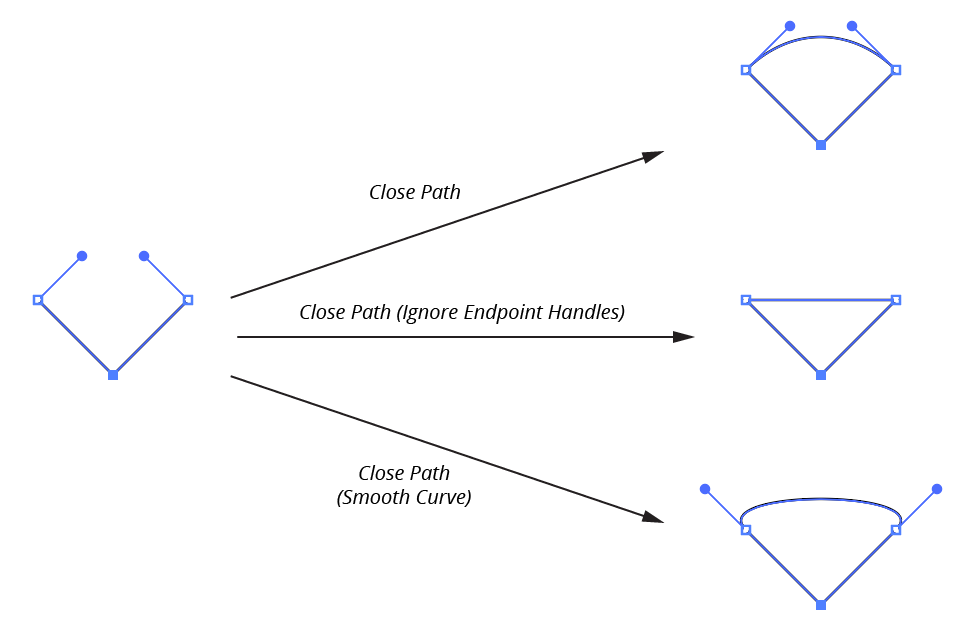
PathScribe Panel Flyout close path
10. Open Path
Converts all selected closed paths into open paths by removing the last segment (point count does not change). This can be useful for fixing paths that are simple two-point lines which have been inadvertently created or imported as closed paths.
11. Reverse Path Direction
Performs the identical function as the Reverse Path Button on the PathScribe panel, but is accessible even when the third row of panel buttons is hidden.
12. Start Path at Selected Point
Available when the selection consists of at least one closed path with exactly one selected point. Forces the closed path to begin at the selected point (it becomes “Point 0”). The change to the path is generally only visible when the path is stroked by a non-uniform brush, or has an arrowhead:

PathScribe Start Path at Selected Point
13. Connect Paths
Available when the selection consists of exactly two open paths, each with a single endpoint selected. Acts similarly to the native Join command, but instead of a straight joining segment, the joining segment will blend smoothly with the existing path segments:
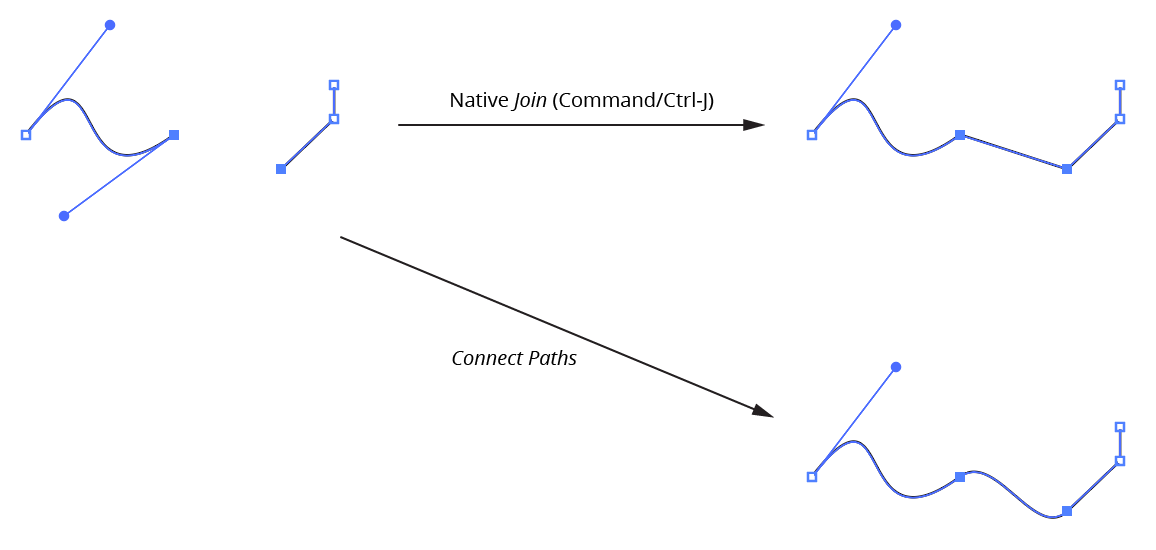
PathScribe Panels Connect Paths
14. Modify Native Join Command…
Allows the native Object > Path > Join menu command (typically called using the shortcut key Command/Ctrl-J) to join the selected paths with smoothly curved segments instead of the default straight segments. Choosing the PathScribe menu item will bring up a small dialog:
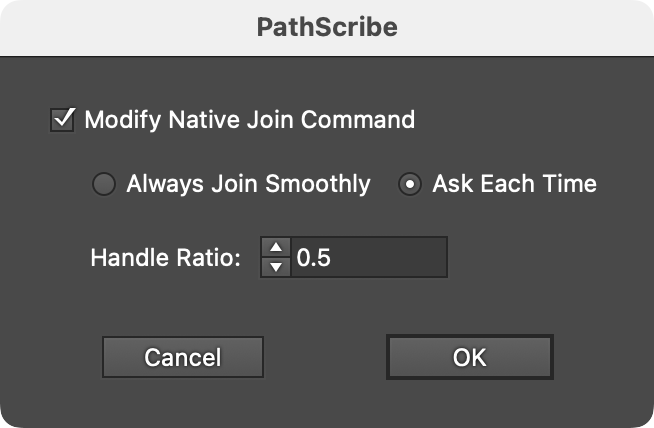
PathScribe Modify Native Join Dialog
Turning on the Modify Native Join Command setting will allow one of two methods to be used:
Always Join Smoothly: Whenever the Join command is used, the paths will automatically be joined smoothly with the originally-specified handle ratio. To join using straight segments, the PathScribe flyout menu item would have to be selected again to turn off or change the setting. Therefore, this setting is best used when you rarely want to join with straight segments, or need to adjust the handle ratio.
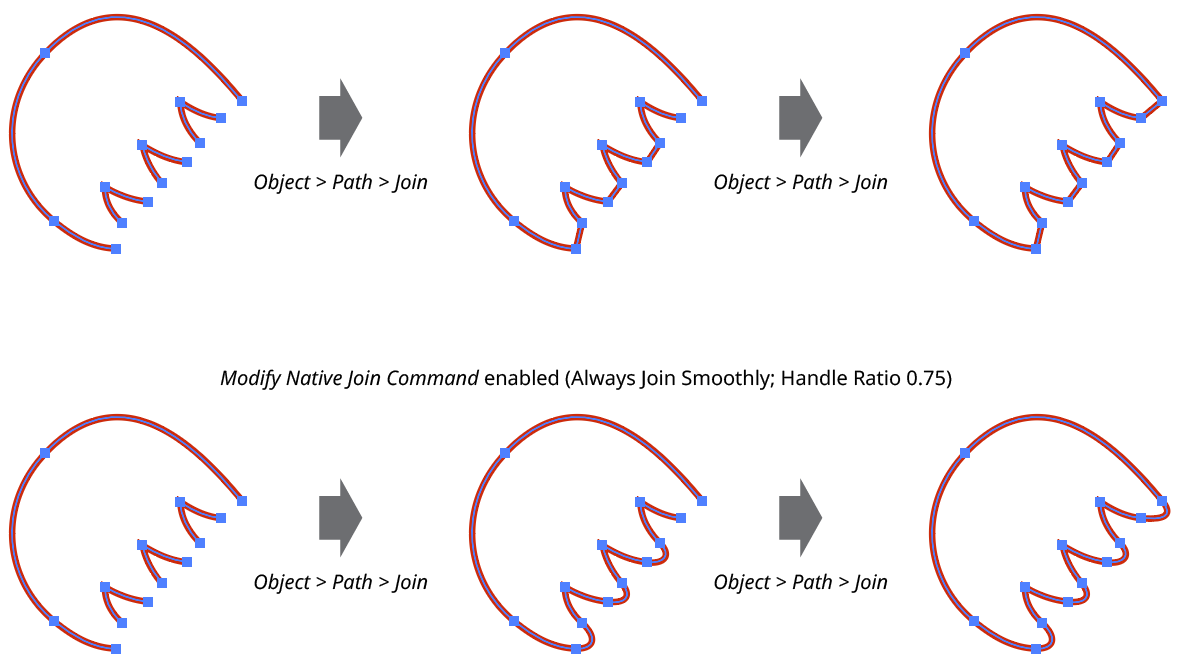
PathScribe Modify Native Join Command Example
Ask Each Time: Whenever the Join command is used, an additional dialog will come up immediately prior to its execution, allowing you to either join in the native way (straight segments), or with smooth curves. If the latter, the Handle Ratio can be changed as well (see below). The Join Type choice affects only that specific instance of the Join command, unless Always Use This Choice is enabled before the dialog is OK’d. In that case, the choice will be remembered and the dialog will not come up again unless the PathScribe flyout menu item is selected once again.
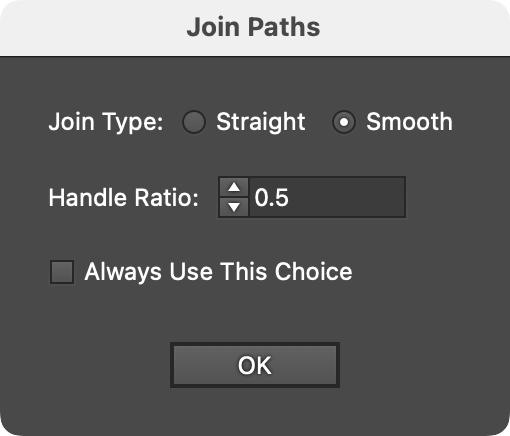
PathScribe Modify Native Join Ask Dialog
The Handle Ratio specifies the length of the automatically-generated handles, in relation to a default value. Higher ratio values will create longer handles, which make the joining curves “protrude” more. The ratio can be specified from 0.1 to 25.

PathScribe Modify Native Join Command Handle Ratio
Note that the native Join command will not convert multiple open paths into a single closed path with a single use; it must be called twice to do this.
15. Add Points to Selected Segments...
Performs the identical function as the Add Points to Selected Segments Button on the PathScribe panel, but is accessible even when the third row of panel buttons is hidden.

PathScribe Add points to selected segments
There are three different spacing methods you can use to add points. For the first two, Equal Spacing and Bezier Spacing, you specify the number of points to add to each selected segment. Equal Spacing creates equal distances between points, as measured along the path. Bezier Spacing places the points such that there are equal distances between t-values, which are a mathematical property of the cubic bezier curves with which Illustrator’s paths are constructed:
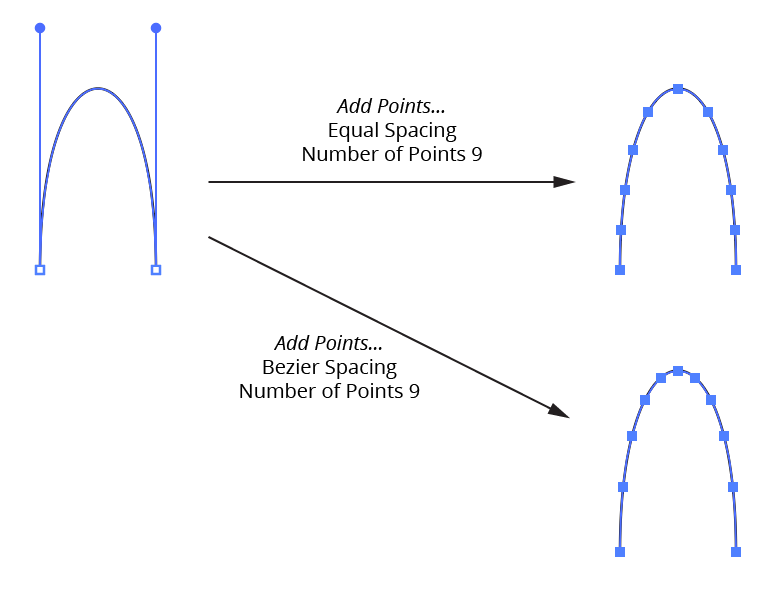
PathScribe Panel Add Point Equal Spacing
For Distance Spacing, you specify the distance between anchor points, as measured along the path. Since this distance will usually not exactly divide the total length of the segment, the “Center within Segment” option allows you to center the new points within each segment:
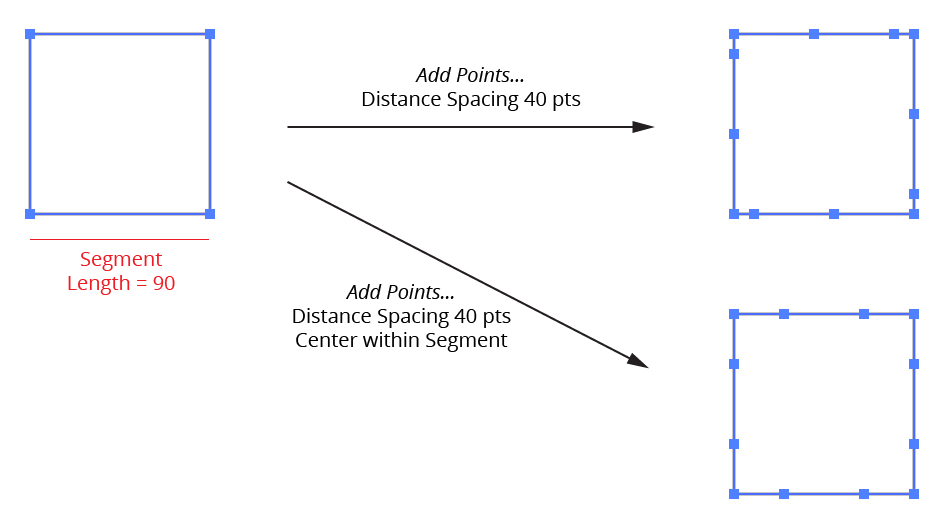
PathScribe Panel Add Points Distance Spacing
You can bypass the dialog and use the values from the previous application of Set Point Selection by holding down Shift while choosing the menu item.
16. Tangencies submenu
Tangencies are places along a path where the path’s direction (and therefore the direction of a line that is tangent to the path at that spot) is either vertical or horizontal (taking into account the general constrain angle). Certain drawing methods include the principle that anchor points along a curved path should be, whenever possible, located at these places of tangency.
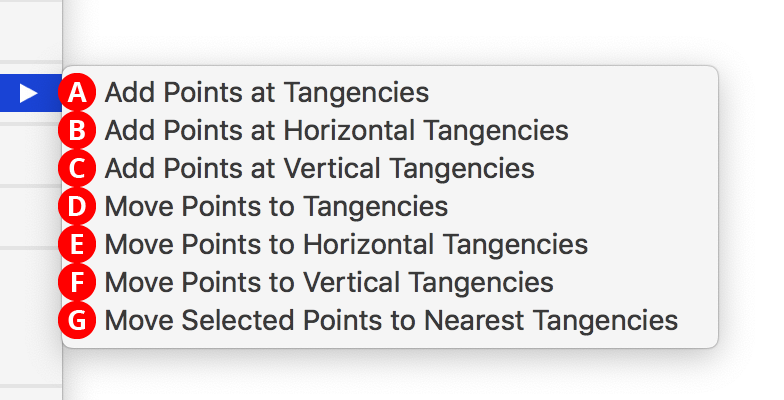
PathScribe Tangencies Flyout Submenu
A. Add Points at Tangencies
B. Add Points at Horizontal Tangencies
C. Add Points at Vertical Tangencies
These menu items add new anchor points, if needed, at places of tangency along all selected paths. Existing anchor points are not changed.

PathScribe Add points at tangencies flyout option
D. Move Points to Tangencies
E. Move Points to Horizontal Tangencies
F. Move Points to Vertical Tangencies
These menu items act similarly to their “Add Points...” counterparts, except that existing anchor points are removed after the tangent points are added if their removal does not alter the path shape appreciably.

Move points to tangencies PathScribe flyout option
G. Move Selected Points to Nearest Tangencies
While the previous items affect every anchor point on a path, this item only moves points which are selected to the nearest horizontal or vertical tangency (if possible).
17. Detect and Adjust Connector Points
Enabled when the Recognize Connector Points preference is enabled, this menu item scans any selected paths for potential connector points and, if found, adjusts their handles.
18. Delaunay Triangulate...
Brings up a dialog which lets you set parameters for creating a “Delaunay triangulation” (a network of triangles) from the selected artwork.
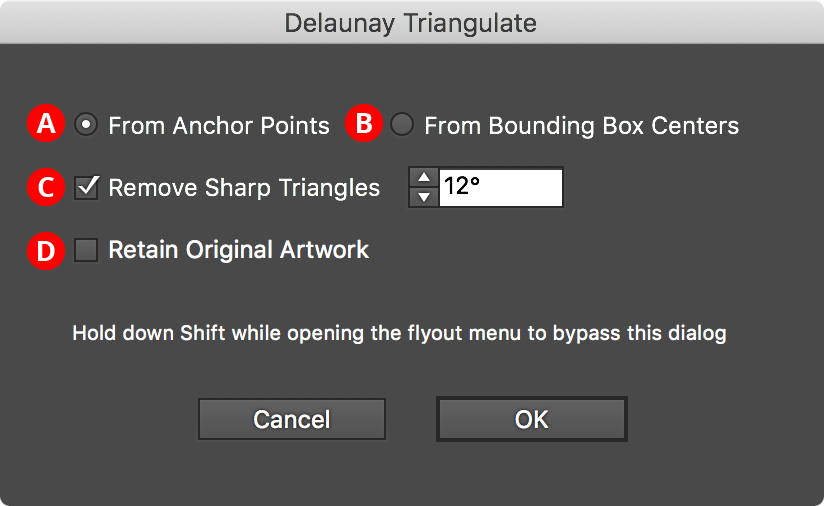
Delaunay Triangulate PathScribe
A. From Anchor Points
Triangles are created using anchor points on all selected paths.
B. From Bounding Box Centers
Triangles are created using the centers of the bounding boxes of all selected art (groups are ignored).
This is useful when creating a triangulation from, say, an expanded Stipple live effect.
C. Remove Sharp Triangles
Delaunay triangulation can create sliver-like triangles that are often undesirable, so this setting lets you eliminate any triangles that have an angle smaller than the threshold value.
D. Retain Original Artwork
When enabled, the artwork used to create the triangles is left in place and the triangles (grouped) are placed above it.
When the Shift key is held down while choosing the menu item, the dialog will not be shown and parameter values that were previously in effect will be used.
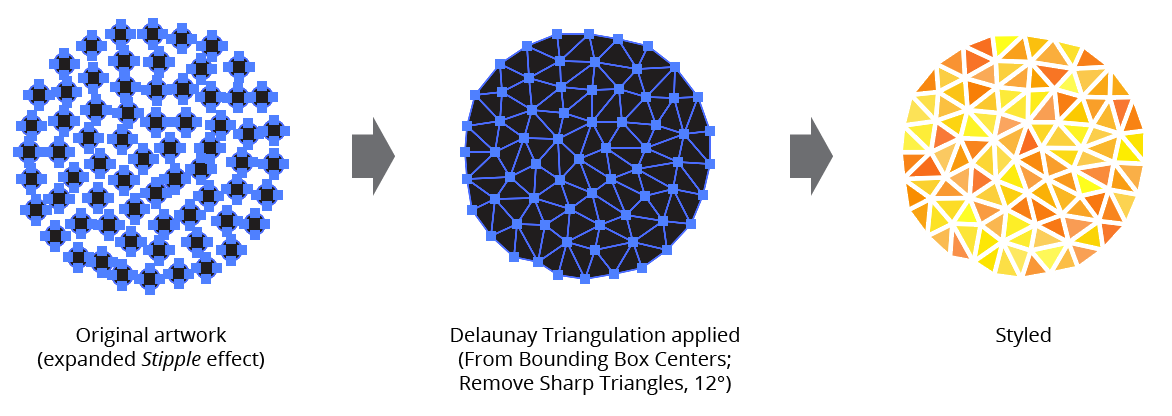
Delaunay Triangulate Points PathScribe
19. Extract Dashes
Converts a path with a dashed stroke into a compound path made up of separate, non-dashed subpaths.
This can be useful for giving the dashes different styles, for example:

PathScribe flyout menu extract dashes
20. Show/Hide Additional Buttons
Shows or hides the third row of buttons on the PathScribe panel. When hidden, most of the buttons’ functionality can still be accessed through the flyout menu commands.
21. Show/Hide Numeric Value Fields
Shows or hides the center section of the PathScribe panel which shows anchor point and handle coordinates.
22. Show/Hide Path Control Area
Shows or hides the bottom Path Control area of the PathScribe panel.
23. Reset Tip Dialogs
If the “Don’t show again” checkbox was used on any tip dialogs (such as the AutoGlue dialog that appears when the feature is enabled), this resets the dialogs so they are shown again.
24. PathScribe Preferences...
Brings up the Preferences dialog.
PathScribe Preferences
The PathScribe preferences dialog can be brought up in three ways: by choosing PathScribe Preferences... in the flyout menu of the panel; by double-clicking on the PathScribe tool icon in the toolbar; or by pressing the Return/Enter key when the PathScribe tool is selected.

PathScribe Preferences
1. Precision
Changes the number of digits displayed in the numerical point editor section of the panel, from 2 to 6; the default is 3.
2. Shift Multiplier
Sets the amount by which the value is multiplied when holding down Shift while clicking a Multiple Handle edit button (see PathScribe Panel: Multi-Handle Mode). Allowed values range from 1 to 100; the default value is 5.
3. Highlight Panel-Selected Points
When enabled, points which are selected using the Select Point 0, Previous Point, or Next Point buttons will be briefly highlighted with a small magenta dot for ease in locating them.
4. Show Anchor Point Coordinate Ranges
Changes the way multiple values are displayed in the anchor point X: and Y: coordinate fields in the panel’s Numeric Values section (see PathScribe Panel: Point Mode - Numeric Value Fields).
5. Keep Paths Selected
When enabled, clicking on a path segment or anchor point retains the selection status of other paths, rather than deselecting them.
6. Shift-Clicking Equalizes Handle Lengths
Changes functionality when clicking with the Shift key held down on anchor points and path segments (see PathScribe Tool: Point Operations).
7. Option/Alt Clicking Adds New Point to Path
Determines the behavior of Option/Alt-clicking on a path segment; when enabled (the default), this results in a new anchor point being added to the path. See PathScribe Tool: Path Segment Operations.
8. Snap to Tangencies
9. Highlight Tangencies
Applicable when the Option/Alt Clicking Adds New Point to Path preference is enabled. They control whether the cursor snaps to tangencies along the path segment and whether all such tangencies are highlighted on the path segment. See PathScribe Tool: Path Segment Operations.
10. Show All Handles on Selected Paths
When enabled, selecting one path segment will cause all path segments to become selected (as if Option/Alt had been held down when marqueeing over a segment), thereby making their handles visible.
11. Don’t Extend Multi-Handles Proportionally
When enabled, multiple handles are extended using the absolute method instead of the proportional method (see PathScribe Tool: Multiple Handle Operations).
12. Handles Stop at Zero Length
When enabled, handles shortened using the absolute method will disappear when they reach zero-length, rather than flipping to the other side (see PathScribe Tool: Multiple Handle Operations).
13. Convert Smooth Points to Corner Points When Dragging Path Segments
When enabled, ensures that dragging a path segment will only affect that segment by changing any smooth points to corner points to unlink the handles and isolate the segment. The preference can be temporarily toggled during a drag by pressing the D key.
14. Keep Path Under Cursor When Dragging
When enabled, the PathScribe tool reshapes path segments much like the Direct Selection tool (the path is adjusted so it passes through the cursor position). For more control, especially when the initial click point is close to one of the path segment’s anchor points, the preference can be disabled.
15. Show Ghost Handles
16. On Current Segment Only
“Ghost handles” are virtual handles that can be converted to real handles by simply dragging them. They appear as small dim circles along the path. Dragging a ghost handle is often the easiest way to extend a single handle from an anchor point. For example, suppose you wanted to change the second point of this path into a connector point, with a single handle:

PathScribe Preference Ghost Handles part 1
Dragging the middle path segment would create the handle, but would also move the existing handle. Dragging the selected point with the native Convert Anchor Point tool or Option/Alt-dragging it with the PathScribe tool would create two new handles, so one of them would subsequently need to be deleted. You could use the numeric value fields of the PathScribe panel to extend a single new handle and then use the PathScribe tool to adjust its position, but using ghost handles, a single click-and-drag with the tool is all that is required:

PathScribe Preference Ghost Handles part 2
When On Current Segment Only is disabled, ghost handles will appear on all segments of the selected path(s) where they are available instead of just the selected segments.
17. Highlight Redundant Points
If enabled, redundant points will be indicated by a triangular annotation when using the PathScribe tool. Those redundant points may then be removed by clicking the button on the panel (see PathScribe Panel: Point Mode - Remove Redundant Points Button).

PathScribe Preferences Highlight redundant points
18. Automatically Remove Redundant Points from Selected Paths
If enabled, whenever a path is selected it is scanned for redundant points, and if any are found, they are automatically removed. The PathScribe tool does not need to be active. Caution: this may sometimes cause unexpected results. For example, if one side of a rectangle is momentarily dragged over the opposite side (with the intention of then moving it back a specific distance), the “zero-width” rectangle will be immediately converted into a two-point line.
19. Smoothing Ratio
Sets the length of automatically-generated handles, as a fraction of the smaller of the distances from the anchor point to adjacent points. The smoothing ratio can range from 0.1 to 0.5, with middle values generally give the smoothest looking curves; the default value of 0.3905 will convert a square to a circle.

PathScribe smoothing ratio
20. Slow-Drag is Default
When enabled, all drags start in slow-drag mode but can be changed to normal drags by holding down the Control key on Mac; on Windows, the Ctrl key can be used if the following preference is enabled.
21. Use Ctrl Key to Toggle Slow-Drag [Windows only]
On Mac keyboards, there are two modifier keys in addition to Shift and Option/Alt (Control and Command), so Control is dedicated to toggling slow-dragging and Command is dedicated to hiding handles during tool drags. Windows machines only have one additional modifier key (Ctrl), so this preference is used to assign it to either the first or second function.
22. Slow-Drag Divider
The amount to “gear down” the cursor movement when a slow-drag is being performed. It can range from 1.0 (which results in no reduction in speed) to 100.0 (extreme reduction), with a default of 5.0. See PathScribe Tool: Overview, Cursor Snapping, and Slow-Drag.
23. Highlight Cursor When Snapping
When enabled (the default), a red ring will appear around the cursor (in addition to the small symbols that appear next to the cursor) when it is over an anchor point or handle (see PathScribe Tool: Overview, Cursor Snapping, and Slow-Drag). If you don’t use Smart Guides, this added visibility generally results in fewer “missed” drags.
24. Highlight Over Path Segments Too
When highlighting is enabled, the ring also will appear when the cursor is over a path segment in addition to anchor points and handles.
25. Show Text Annotations
When highlighting is enabled, a text annotation will appear in addition to the red ring, indicating the type of snap (In handle, Out handle, Corner point, Smooth point, Open path, or Closed path).
26. Boxed Style
When text annotations are enabled, changes their style so they appear in a box below and to the right of the cursor, rather than to its left.

PathScribe Preferences Boxed Style
27. Connector Threshold
Specifies the number of degrees that the angle of a potential connector point can deviate from the ideal and still be recognized as a connector point. Allowed values range from 1° to 180°; the default is 5°.
28. Enable Smart Smooth
Turns the Smart Smooth feature on and off. See PathScribe Panel: Point Mode - Point and Path Buttons.
29. Smart Smooth Threshold
Specifies the number of degrees that the angle of a handle can deviate from the ideal (180° opposed from the other handle) and still be considered for smart smoothing.
30. AutoGlue Tolerance
Specifies the maximum distance apart that two anchor points (or handles) must be to automatically be glued together when using AutoGlue. The default is 0.002 pt. Setting the tolerance too high may result in anchor points being glued when they shouldn’t be.
31. Help Button
Opens the help documentation in the Astute Manager. If this does not automatically appear, please ensure your Astute Manager is running first.
32. Settings Manager
The Settings Manager popup menu provides access to saving, managing, and applying preference settings.
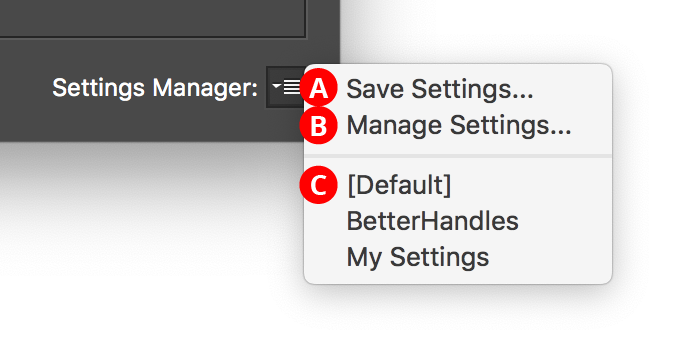
PathScribe Settings Manager Menu
A. Save Settings...
When you save the preference settings, all of the current settings in the preferences dialog are captured in a file which can be recalled later.
B. Manage Settings...
Brings up the Manage Settings dialog, which lets you rename or delete existing settings files:
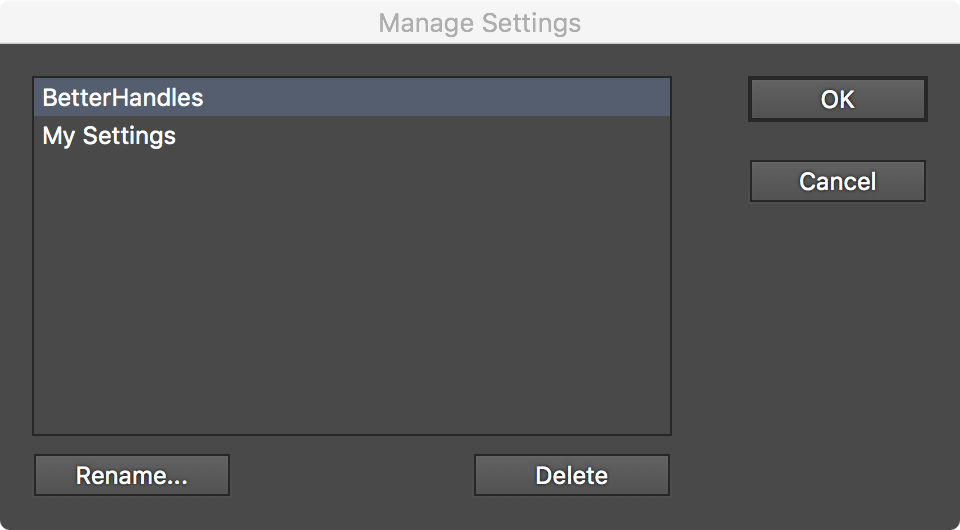
PathScribe Preferences manage settings
C. Settings List
Choosing a settings file from this list will change the preference settings to match the state of the panel when the settings file was saved (or, the case of “[Default]”, to the default values).
